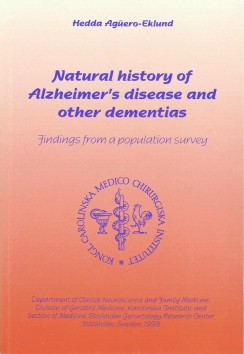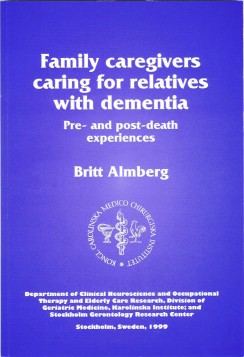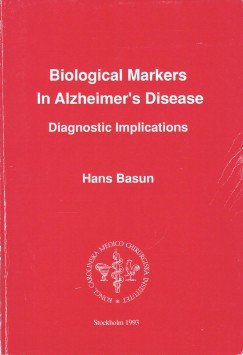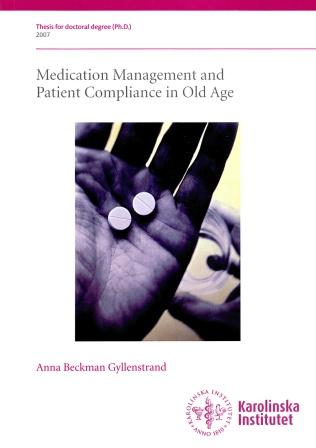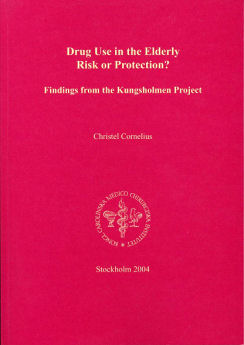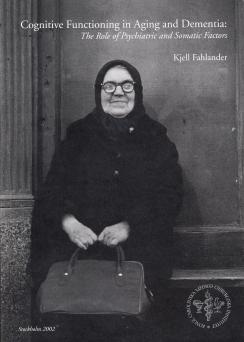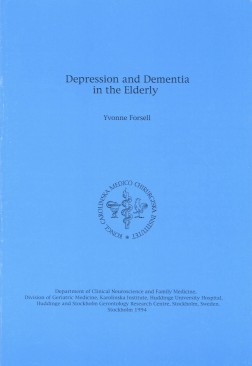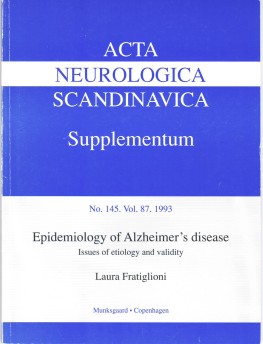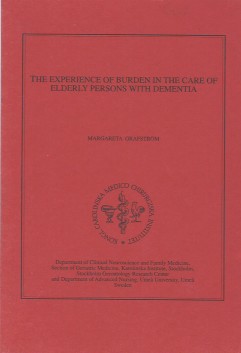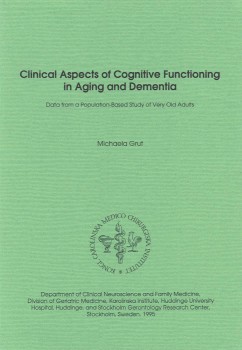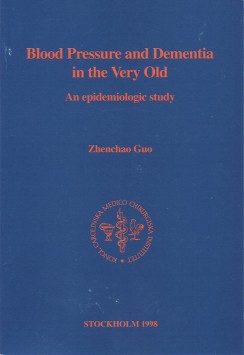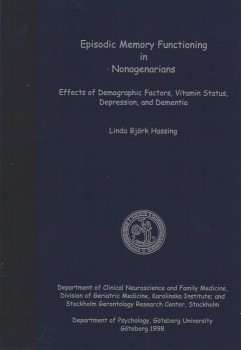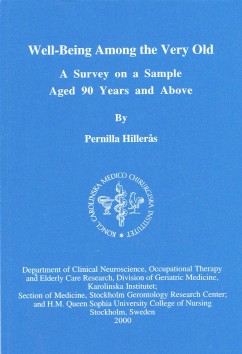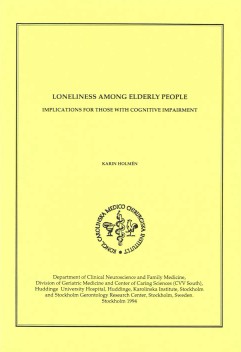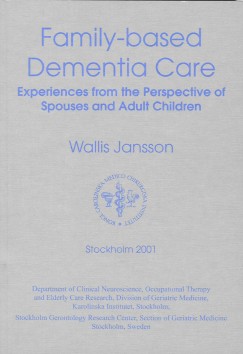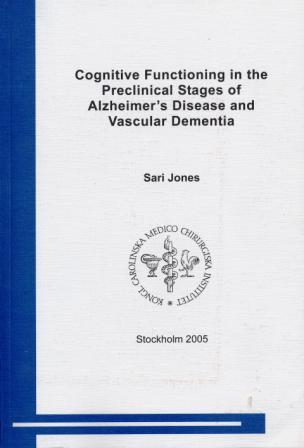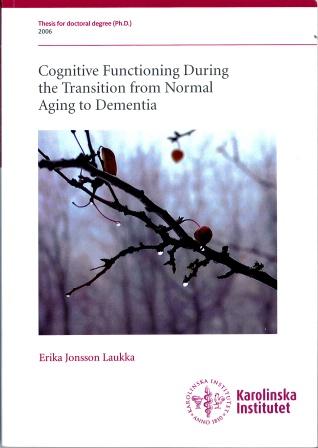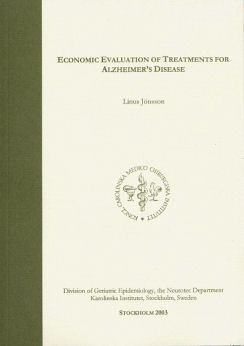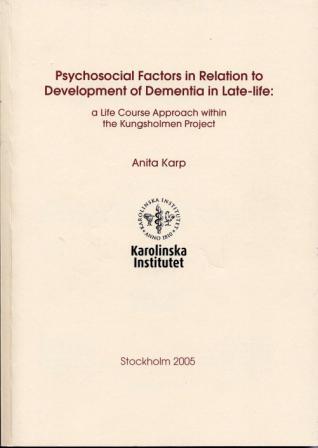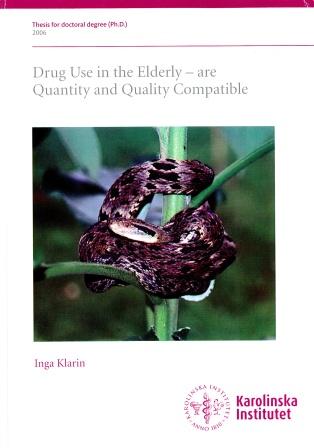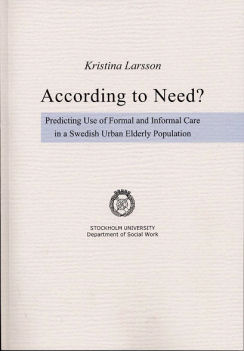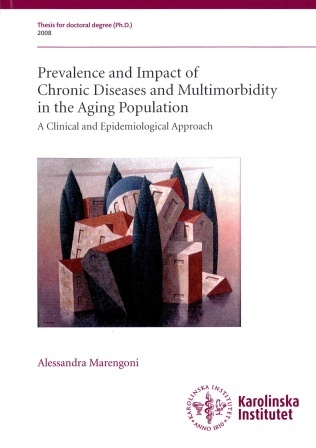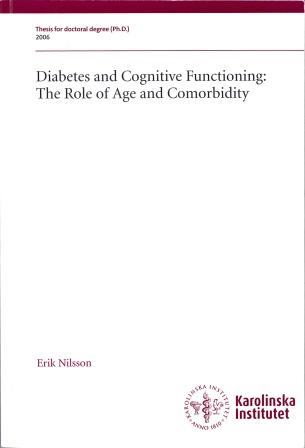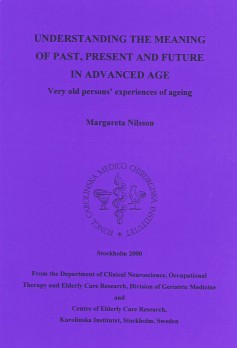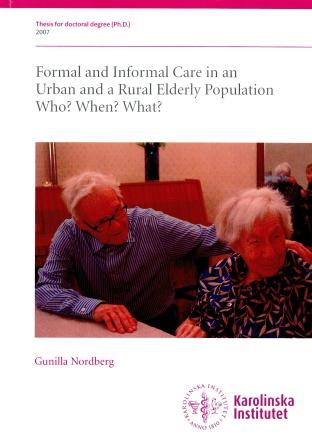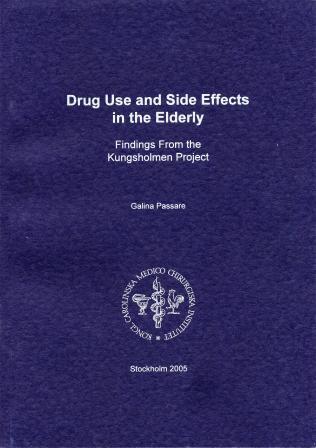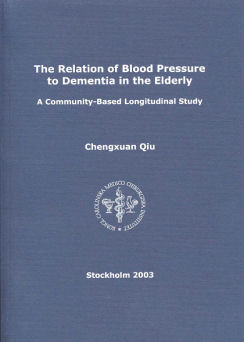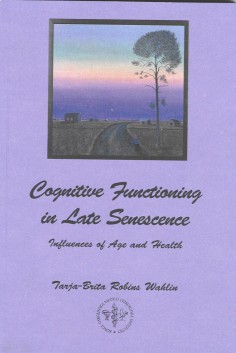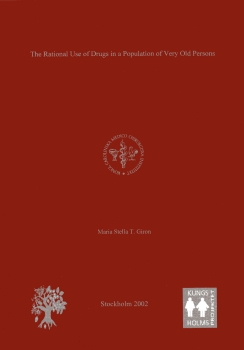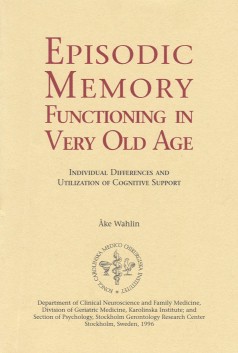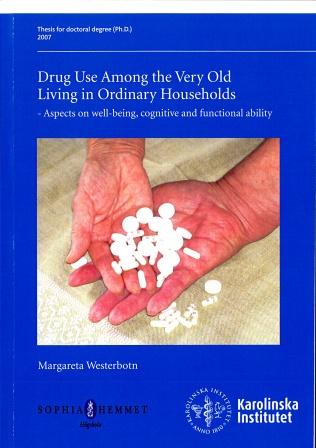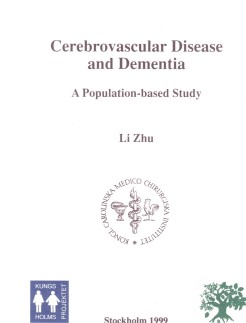2008
2007
2006
- Jonsson-Laukka
E . Cognitive functioning during the transition from normal aging
to dementia. 2006.
- Klarin
I. Drug
use in the elderly - are quantity and quality compatible. 2006.
- Nilsson
E. Diabetes and cognitive functioning: the role of age and comorbidity.
2006.
2005
- Jones
S . Cognitive functioning in the preclinical stages of Alzheimer´s
Disease and vascular dementia. 2005.
- Karp
A. Psychosocial
factors in relation to development of dementia in late-life: a life
course approach within the Kungsholmen Project. 2005.
- Passare
G. Drug use and side effects in the elderly. Findings from the Kungsholmen
Project. 2005.
2004
- Cornelius
C. Drug Use in the Elderly. Risk or Protection? Findings from
the Kungsholmen Project. 2004.
- Palmer
K. Early detection of Alzheimer's disease and dementia in the general
population. 2004.
2003
- Jönsson
L. Economic Evaluation of Treatments for Alzheimer´s
Disease. 2003.
- Qiu
C. The Relation of Blood Pressure to Dementia in the Elderly. A
Community-Based Longitudinal Study. 2003.
2002
2001
2000
- Hillerås P. Well-being
among the very old. A survey on a sample aged 90 years and above. 2000.
- Nilsson
M. Understanding the meaning of past, preent and future in advanced
age. 2000.
- von Strauss E. Being old in our society:
Health, functional status, and effects of research. 2000.
1999
1998
- Agüero Torres H. Natural history of Alzheimer´s disease and other dementias - findings from a population based study. 1998.
- Guo Z. Blood pressure and dementia in the very old. An epidemiologic study. 1998.
- Hassing L. Episodic memory functioning in nonagenarians:
Effects of demographic factors, vitamin status, depression and dementia.
1998.
1996
1995
1994
- Forsell Y. Depression and dementia in the elderly. 1994.
- Grafström M. The experience of burden in the care of elderly persons with dementia. 1994.
- Holmén K. Loneliness among elderly people.
Implications for those with cognitive impairment. 1994.
1993
- Basun H. Biological markers in Alzheimer´s disease. Diagnostic implications. 1993.
- Fratiglioni L. Epidemiology of Alzheimer´s
disease. Issues of etiology and validity. Acta Neurol Scand 1993;87
(suppl145):1-70.
ABSTRACT
In conclusion, our results support the hypothesis that the onset of dementia is variable. However, as memory problems are very common in early stages, when these problems present, dementia assessment is strongly recommended. EPS are not confirmed unfavourable prognostic factors. Our finding that as many demented people live at home as in institutions underscores the need for more attention by health care planners to the large requirements for domiciliary help as well as institutionalized care of demented elderly. Dementia is a long and progressive process, a major cause of functional dependence and major risk factor for death in the elderly. It is possible to identify demented subjects with a worse prognosis by using clinical and demographic data. Clinicians and health care planners should be aware of the potential usefulness of functional dependence, as measured by activities of daily living, which is a good predictor of both shorter survival and more rapid cognitive decline.
Hedda
Aguero-Eklund, 1998
![]() Top
Top
ABSTRACT
Almberg B. Family caregivers caring for relatives with dementia. Pre- and post-death experu Doctoral dissertation. NEUROTEC, Karolinska Institute, Stockholm; and Stockholm Geront Research Center, Stockholm, Sweden. Correspondence to: Stockholm Gerontology Res Center, Box 6401, S-113 82 Stockholm, Sweden, e-mail: Britt.Almberg@neruotec.ki.se. ISB 628-3846-6.
The purpose
of this thesis was to describe caregiving relatives' experiences pre-
and post-death relative with dementia disease. This thesis involved
52 caregivers for demented elderly persons 66 non-caregivers for non-demented
elderly persons who were included in the Kungsholmen Project, a population-based
study of people aged 75 years and over. The Burden Questionnaire (Grafström
et al. (1992), the Burnout Measure (Pines et al. 1981), the Patient
Hassles (Kinney & Stephens (1991), and the Nursing Home Hassles
Scale (Stephens et al. 1991) were in this thesis. The Stress Process
Model (Pearlin et al. 1990) was applied in order to present the dif
stressors in a caregiver's career. Study 1 There was not always a
difference in strain between the caregivers and the non-caregivers.
In a cross-gender comparison, females' total experiences proved to
be the most strained. ' controlling for gender, the females did not
suffer uniformly. Within a same-gender group of caregivers, the results
indicate that the males caring for demented elderly persons experienced
lack of positive outlook and a limitation of social support. Study
2 In the caregiver group, older wives and daughters were the most
likely to report burnout their lives. Limitations in social life,
poor health and a lack of positive outlook on caring we most important
factors when explaining burnout. Study 3 The caregivers in this study
used different coping strategies, depending on whether they felt burned-out
or not. Those who experienced burnout used emotion-focused strategies
caregivers who did not experience burnout, however, used problem-focused
strategies more Furthermore, the caregivers who did not feel burnout
used the emotion-focused strategy of acceptance, frequently in combination
with the problem-focused strategies of seeking information and seeking
social support. The elderly person's living place (home or institution)
in this study did not appear to have any significant impact. Study
4 The caregivers in this study who had their demented elderly relatives
institution experienced patient hassles (cognitive, behaviour, basic
ADL) and nursing home h (caregiver-staff, patient-staff, practical/logistical).
The analysis showed the nursing home h to be the stressors explaining
variance in burnout. Study 5 Bereaved caregivers who reported more
positive appraisal (pre-death) were likely t relieved after the death.
They were also satisfied with their support. Caregivers expressed
more often when the same person(s) helped them pre- and post-death.
Caregivers who reported being exhausted and having a breakdown during
the caregiving process expressed negative thoughts and guilt in the
post-death phase. Finally, caregivers in the detachment phase who
said they were able to say good-bye to their relatives often expressed
that they were ready to go on with their lives. KEY WORDS: Dementia,
caregiver, non-caregiver, strain, burnout, coping, social support
bereavement, grief, gender differences, elderly living place, population-based
project.
ABSTRACT
The clinical
diagnosis of Alzheimer's disease (AD) is difficult and an antemortem
biological marker serving the function to confirm the presence or
absence of the disease would be of great help in the diagnostic procedure.
Today, this is possible with biopsies of the brain and with noninvasive
methods in a few families with known pathogenic mutations in the amyloid
precursor protein gene. In this amino acids, cobalamin, metals and
white matter hyperintensities (WMH) were studied in AD subjects as
putative biological markers of the disorder.
In study I, reduced levels of plasma taurine and glutamate and cerebrospinal
fluid (CSF) glycine, valine in AD patients compared with healthy volunteers
were observed. Also low CSF/plasma ratios of alanine, glutamine, glycine,
phenylalanine, valine were observed in the AD cases. It is suggested
that these changes provide evidence for a disruption of amino acid
metabolism that may occur secondary to a disorder of carbohydrate
metabolism in AD. Finally, the observed correlations between glutamate
and glutamine levels and copying ability and behavioural functions,
respectively, would suggest that measurements of these two amino acids
may serve as useful early markers for visuo-spatial and behavioural
deficits in the disorder.
The plasma levels of aluminium, cadmium, mercury and selenium were
increased in study 1 the contents of iron and manganese were lower
in the AD sufferers as compared with nondemented individuals. In CSF
there were low levels of cadmium and calcium and increased content
of copper cases. Calcium in both blood and CSF of AD patients correlated
inversely with memory and co^ functions and aluminium in CSF were
related with changes in behaviour.
Low CSF levels of cobalamin were observed in AD patients as compared
with healthy control subjects in study II. Furthermore, the cobalamin
concentrations could not be related to cognition, behaviour or severity
of dementia. The volumes of the subarachnoid spaces, ventricles and
white matter changes in brain observed on magnetic resonance imaging
were not correlated to CSF or serum concentrations of cobalamin.
In study IV, the participants were a population-based cohort of 545
subjects aged over 74 years. The results indicate that serum cobalamin
concentrations decrease in normal ageing, but not in A association
between AD and low cobalamin levels were found. AD patients had normal
cobalamin as compared with aged-matched subjects. The lower cobalamin
concentrations observed in AD sufferers still living in their own
home seemed to be related to eating habits.
In study V, WMH were assessed with a low field magnetic resonance
imager on AD sufferers and subjects with vascular dementia (VaD).
The total volume of the WMH as well as the regional distribution of
these changes differed significantly between vascular dementia and
AD. The regional distribution of the WMH differed between the groups
with significantly more changes in the posterior part of the brain
as well as in the right hemisphere in the vascular demented as compared
with the AD patients. No correlations between cognitive dysfunction
and the degree of the WMH were found.
In conclusion, the changes in amino acid concentrations seem to be
a secondary phenomenon due to impaired carbohydrate metabolism in
the brain, with the exception of glutamate and glutamine which may
serve as useful diagnostic markers for visuo-spatial and behavioural
deficits in the disease. There are significant changes in metal concentrations
in AD sufferers. The relevance of these results are unclear. Cobalamin
levels are neither reduced nor related to cognition in AD. Moreover,
it is not correlated to brain changes observed on MRI. Low serum cobalamin
concentration in AD subjects may be related to eating habits. WMH
can contribute to differentiate between AD and VaD, but WMH seem not
to be related to the degree of global cognitive decline in dementia
and whether they play a causative role in the development of dementia
needs to be further investigated.
ISBN 91-628-1019-7.
ABSTRACT
In
old age, many physiological functions decrease and many older people
also suffer from multiple chronic conditions. This leads to high
drug consumption, but may also impair the ability to manage these
medications. The first objective of this thesis was to describe
different aspects of medication management (MM) in the elderly,
such as opening medicine containers, tablet swallowing and the cognitive
components of MM. A second objective was to explore the relationships
between MM and functions, demographics and compliance in an elderly
population. Thirdly, we wanted to explore what older people do when
facing difficulties with MM.
For this thesis, three different populations were used: the Kungsholmen
project (paper I and III), the SWEOLD (paper II) and the Swedish
National study on Aging and Care (SNAC) (paper IV). In the first
and second studies we used tests of opening of containers and of
MM respectively. In the third study data were collected on tablet
sizes and volumes and correlated to age, gender, housing and self-reported
ability to swallow medicines. For the fourth study we developed
a questionnaire regarding several aspects of MM and patient compliance,
also including questions of what the elderly do when facing difficulties
with MM.
We found that a large proportion of older people living in the community
have difficulties with MM. In the first study this was exemplified
by the finding that a fairly large proportion was not able to open
three different kinds of medicine containers. We also found that,
among persons that did not manage to open the containers, a large
proportion did not receive help with their own medications. In the
second study we found that a test of MM including more cognitively
demanding processes of MM, was very difficult to perform without
making errors on one item or the other. In addition, the results
from this test correlated poorly to the selfreported ability to
manage medications.
In the third study we looked at self-reported ability to swallow
tablets in relation to tablet sizes and volumes. The results show
that there are older people that do experience difficulties when
swallowing medicines and that they had a larger volume of tablets
than others.
For the fourth study we used the theoretical framework of the International
classification of functioning, disability and health (ICF). The
questionnaire contained questions regarding a number of different
aspects of MM, functions of importance to MM and patient compliance.
We found that functions were highly correlated to activities of
MM. We also found that functions and activities of MM both separately
correlated to patient compliance. When asked about strategies when
experiencing difficulties with their medications, the elderly in
our sample reported that they find ways to manage these difficulties
with or without help or aids of any kind.
Keywords:
Medication management, patient compliance, aging, cognition, population-based
study
ISBN 978-91-7357-166-1.
ABSTRACT
The general
aims of this thesis were to examine the occurrence of depressive symptoms
three years before the diagnoses of depression and Alzheimer's disease
(AD), and to study the effects of depression on cognitive functioning
in aging and AD. Five empirical studies were conducted. All data were
taken from the Kungsholmen Project, a longitudinal population-based
study of aging and dementia targeting persons who are 75 years and
older, living in the Kungsholmen district in Stockholm, Sweden.
The specific objectives of Study I were to examine preclinical markers
of depression, in terms of presence and severity of depressive symptoms,
as well as to examine whether cognitive deficits were present during
the preclinical period of old age depression. The chief aim of Study
II was to investigate depressive symptomatology, with respect to mood-
or motivation-related symptoms, in the preclinical phase of AD. In
particular, Study II examined mood- and motivation-related symptoms
in relation to subjective memory problems to elucidate whether depressive
symptoms reflect insight into the dementing process, or is rather
a part of the neurodegenerative process. Study HI and IV investigated
the influence of depression on AD-related deficits in various cognitive
domains (e.g., episodic memory, short-term memory, verbal abilities,
visuospatial skill) in mild to moderate stages of AD, whereas Study
V examined the influence of depression on global cognitive functioning
longitudinally, from the preclinical stage of AD to the time of diagnosis.
Study V also addressed whether a concurrent diagnosis of depression
causes more rapid decline in global cognitive functioning over a 3-year
interval among persons who were going to develop AD.
Findings from Study I showed that depressive symptoms are elevated
preclinically in old age depression. Persons who were to be depressed
showed a greater number of depressive symptoms (i.e., dysphoria, appetite
disturbance) and their symptoms were also more severe (i.e., dysphoria,
appetite disturbance, lack of interest, psychomotor disturbances),
compared to individuals who remained non-depressed. In addition, depressive
symptoms were associated with somewhat poorer global cognitive functioning.
These data suggest that there are preclinical markers for old age
depression. Study II revealed that depressive symptoms are elevated
in preclinical AD as well. There was a predominance of motivation-related
(e.g., lack of interest, concentration difficulties, loss of energy)
over mood-related (e.g., dysphoria, feelings of guilt, thoughts of
death) symptoms. This pattern remained after controlling for subjective
memory complaints, indicating that the elevation of depressive symptoms
may not merely reflect self-perceived cognitive deficits. Thus, depressive
symptoms may be a part of the pathological process of AD. The studies
(III and IV) examining the effects of depression on AD-related cognitive
deficits showed no impact of depression among mild to moderate cases
of AD in episodic memory, verbal ability, and visuospatial skill.
However, depression-related deficits in global cognitive functioning
were observed in the preclinical phase of AD (Study V), although a
diagnosis of depression did not result in greater decline over a 3-year
follow-up interval.
To summarize the findings of this thesis, depressive symptoms were
found to be elevated preciinically in both depression and AD. However,
different patterns of symptoms were present. Mood-related symptoms
were more elevated in depression, whereas motivation-related symptoms
were dominating in AD. In terms of depression-related effects on cognitive
functioning in AD, theresults indicated that, already at a very early
clinical stage of AD, the neurodegenerative process overshadows the
impact of depression, although this condition is associated with cognitive
deficits in normal aging.
ABSTRACT
English
This thesis deals with different aspects of drug use in a population-based
study with participants 75 years and older. The study was performed
within the Kungsholmen Project in Stockholm, Sweden, using data from
the baseline survey (1987-89), and the first (1991-93) and second
(1994-96) follow-ups. In the first two papers we used cross-sectional
data (n=1810) to describe the drug use pattern in this population
(I), and to examine the association between self-reported symptoms
and drug use (II). In the next papers (III-V) a dementia-free cohort
(n=1301) was followed up to six years to explore the association between
the risk of Alzheimer's disease (AD) and dementia, and the use of
aspirin and NSAIDs (III), the use of glucocorticoids (IV), and the
use of calcium channel blockers (V). We also examined whether the
apolipoprotein E epsilon 4 (apoE e4) allele influenced the effect
of these drugs (III-V). The main findings are summarized below. Study
I: Sedatives/hypnotics, diuretics, cardiac therapy agents, and minor
analgesics and anti-pyretics were the most commonly used drug groups,
accounting for more than 40 of the total medicines used. Women used
a larger number of drugs than men (3.4 vs 2.6). Anti-thrombotic agents
was the only drug group that men used more than women. People living
in sheltered accommodation used more medicines than those living in
their own homes or nursing homes. Study II: The most commonly reported
symptoms were pain and tiredness. Women reported more symptoms than
men. Many of the associations between symptoms and drug use reflected
established treatments. However, tiredness, loneliness, and depressed
mood were associated with use of anxiolytics and hypnotics/sedatives,
which might reflect inappropriate treatment. Study III: An increased
risk of Alzheimer's disease (AD) was seen among aspirin users that
did not carry the apoE e4 allele. A possible protective effect against
AD was seen among long-term users of NSAIDs, regardless ofapoE e4
status. Study IV: Use of glucocorticoids was associated with a significantly
higher risk of dementia in carriers of the apoE e4 allele (RR 2.39,
95 CI 1.02-5.58). Study V: Use of calcium channel blockers did not
protect against AD and dementia, regardless ofapoE e4 status. In summary,
women used more medicines and reported more symptoms than men did.
Self-reported tiredness, which was associated with use of anxiolytics
and sedatives/hypnotics, might reflect too high or too low doses,
or an inappropriate choice of drug. Experience of depressed mood was
more common among users of sedatives/hypnotics, which could indicate
an under-treatment or inappropriate treatment of depression in this
population. Up to three-years use of NSAIDs might protect against
AD, since no one in this group developed AD three years later. The
association between aspirin and an increased risk of developing AD
among those with no apoE e4 allele could indicate an alternative mechanism
of developing AD in this group. Carriers of the apoE e4 allele that
used glucocorticoids showed an increased risk of developing dementia,
which suggests a possible vulnerability to gluco-corticoids in this
group. Finally, although calcium channel blockers have been found
to be neuroprotective in many experimental studies, we could not find
a protective effect against dementia in this population. Key-words:
drug use, elderly, dementia, Alzheimer's disease, aspirin, NSAIDs,
glucocorticoids, calcium channel blockers, apolipoprotein E, population-based
study.
ISBN 91-7349-805-X © Christel Cornelius, 2004
ABSTRACT
This
doctorial thesis concerns the role of psychiatric and somatic factors
in aging and dementia. Five studies are included, all based on data
from the Kungsholmen Project, a population-based longitudinal study
of aging and dementia that was conducted in Stockholm, Sweden during
1987-2000.
Of the five studies, all but one mainly dealt with cognitive functioning
in groups of participants that were diagnosed with dementia, whereas
one study focused on cognitive functioning in nondemented persons.
Four different disorders or conditions were explored with respect
to their effects on cognitive functioning: depression in combination
with Alzheimer's disease (AD), low levels of vitamin B in combination
with AD, cardiovascular signs (CVS) among nondemented participants,
and the similarities/differences in the nature of cognitive deficits
in vascular dementia (VaD) and AD.
In general, the additional impact on cognitive functioning from
depression as well as of low vitamin B levels were found to be limited
when participants were already diagnosed as demented, or, as in
the vitamin B study, were in a preclinical phase of the dementing
disease. Among nondemented persons, however, CVS were found to contribute
significantly to the variation in cognitive performance, after controlling
for other factors that have an impact on the results. In addition,
the differences in patterns of cognitive functioning between persons
with AD or VaD, respectively, were found to be small.
These results are discussed in terms of the expectation of aggravated
cognitive deficiency when additional pathological conditions are
added to dementia. Specifically, it is argued that when the cognitive
performance is already seriously disturbed by a major cognitive
disorder, such as AD, the contribution from other factors might
not be expected to be additive. The main reason for this is that
the differences in magnitude of impact from the studied disorders
are too large, making it difficult to detect effects of the condition
with the least dramatic influence on cognitive functioning. The
dementing disorder might have reduced the potential variability
in cognitive functioning, resulting in conformity among persons
with dementia, and as AD progresses, a "functional floor"
may be reached, where systematic variability in cognitive performance
approaches zero. As was indicated in one of the studies, the reduction
of systematic variability in cognitive functioning might start early
in the disease, even before the time of the dementia diagnosis.
Depression, low levels of vitamin B, and type of dementia are among
those factors that have reduced importance for cognitive variability
among older demented adults. However, among nondemented older adults,
signs of cardiovascular deficiency are related to cognitive performance,
and mediate a substantial proportion of the age-related cognitive
variability.
ISBN 91-7349-246-9
![]() Top
Top
ABSTRACT
Depression
and Dementia in the Elderly Forsell Yvonne, Department of Clinical
Neuroscience and Family Medicine, Geriatric Medicine, Karolinska Institute,
Huddinge University Hospital, Huddinge, Stockholm Gerontology Research
Centre, Stockholm, Sweden. Depression and Dementia, both prevalent
disorders in an elderly have a complex not fully understood relationship.
Depression accompanied by a cognitive dysfunction -"depressive
pseudodementia", "dementia syndrome of depression"-
as well as dementia accompanied by a depression. Since dementia is
a progressive disorder there are also p variation during the natural
course.
The studies in this thesis are based on a population of persons aged
75 and over registered in the parish of Kungsholmen, Stockholm, Sweden.
Data from physician's examination, nurse interviews, cognitive tests
and interviews are used.
In study I demented subjects were divided according to the severity
of the disorder using CDR and DSM-III-R staging scales, respectively.
between the two staging scales was generally good, with the lowest
in the most important group of mild dementia. When MMSE was staging
scale the agreement with CDR and DSM-III-R respect moderate.
The variation of psychiatric and behavioural symptoms the course of
dementia was analysed in study II, comparing informs physician's examinations
and informant interviews. The symptom grouped into clusters using
principal components analysis. Little agreement was found between
the two sources of information concerning depression. However, there
was agreement about an increase in inactivity symptoms as the severity
of dementia increased.
The use of DSM-III-R diagnosis Major Depressive Syndrome in versus
non-demented subjects was compared in study III. The included in the
diagnosis, when analysed in a factor analysis, clustered in a mood
and motivation disturbance factor. The motivation factor increased
the severity of dementia while the mood factor increased initially
and then decreased.
Outcome of depression after three years in non-demented and persons
was analysed in study IV. In the non-demented depression while in
the demented persons it tended to disappear as the progressed.
The performance of the non-demented depressed on cognitive analysed
in study V. Both the encoding and retrieval processes were found to
be affected, compared to non-depressed, non-demented persons. The
depressed were able to use memory support when it was provided.
The association of age, sex, disability and cognitive dysfunction
to the symptoms of Major Depression were analysed in study VI. In
a factor analysis the symptoms clustered as a mood and motivational
factor. dysfunction affected the two factors similarly as in the previous
stud: had a higher score on mood disturbance factor. Age was unrelated
to both symptoms. Decreased ADL was associated with an increase both
in motivational disturbance factors.
Key words: Depression, Dementia, Elderly population, CDR, CPRS, MADRS,
DSM-I
ABSTRACT
This
thesis concerns the epidemiology of Alzheimer's disease (AD) and some
aspects of the validity of such studies.
Three studies on AD etiology have been performed. The first is a case-control
study on early-onset AD and a wide range of putative risk factors.
The cases were gathered from a clinical study on AD carried out in
Italy. The other two etiological studies deal with late-onset AD and
are a prevalence study on sociodemographic variables and a case-control
study on selected putative risk factors. These two studies to were
performed within a population-based study on ageing and dementia that
is ongoing in Stockholm, Sweden. The main results are: (1) The prevalence
of AD increases with age, even in advanced ages. (2) The prevalence
of AD does not vary by gender and education. (3) The main risk factor
for both early-and late-onset AD is the familial aggregation of dementia.
(4) A second risk factor for early-onset AD may be the advanced age
of the mother at index delivery, but this result needs confirmation.
No other risk factors reported by others as associated with early-onset
AD emerged in our study. (5) High relative risks were found for alcohol
consumption and manual work in late-onset AD. Manual work could be
an indicator of occupational exposures as well as life conditions
or habits. Although both these results may be affected by bias, they
are provocative for future research.
Three validation studies were carried out on three different aspects.
The first study investigated the reproducibility of AD diagnosis according
to the DSM-III-R criteria. A second study concerned the effect of
education on the positive predictive value of the Mini-Mental Status
Examination (MMSE) used as screening test for dementia in the population
survey in Stockholm. The third study compared the information obtained
by surrogate informants with the subjects' reports on the putative
risk factors studied in the-Italian case-control study. The main results
are: (1) The K index of the agreement between different clinicians
were 0.54 and 0.58 for the diagnosis of dementia and AD. The agreement
on dementia increased to a K value of 0.70 when some modifications
were added to the diagnostic criteria. (2) The positive predictive
values of the MMSE estimated from a logistic regression model were
very similar in the two educational groups (elementary schooling vs
high school or university). (3) The non response of the surrogate
informants ranged from 0 to 27. The agreement between the subjects
and the informants was moderate or better (K index over 0.40) in 73
of the examined possible risk factors.
In conclusion, our results show that the age and familial aggregation
are the only certain risk factors for early- and late-onset AD. All
the other results suggest interesting working hypotheses for the future
rather than definite conclusions. Finally, more attention to the study
validity seem necessary, although our results on the diagnostic reproducibility,
accuracy of the MMSE, and exposure assessment precision were encouraging.
ISBN: 87-16-15030-9 ISSN: 0065-1427
ABSTRACT
Margareta Grafstrom, Department of Clinical Neuroscience and Family Medicine, Section Geriatric Medicine, Karolinska Institute, Stockholm Gerontology Research Center, Stockholm, and Department of Advanced Nursing, Umea University.
The experience
of burden in the care of elderly persons with dementia The relatives'
experience of burden when caring for a demented elder person and how
burden changes over a period of time were investigated. The care receivers
were included in a longitudinal population-based study ( ageing (the
Ageing and Dementia Project). In the first phase of this study 219
relatives with cognitively impaired and 255 relatives with not cognitively
impaired elderly were interviewed. The relatives of the cognitively
impaired elderly reported a higher physical and psychological burden
and a greater social and affective limitation than the relatives of
t non-cognitively impaired elderly (I). The relatives of demented
elderly institutions reported similar feelings of burden to those
experienced by t home-caring relatives, but the use of psychotropic
drugs was lower and the use of somatic drugs and medical facilities
was higher in the group relatives with demented elderly in institutions
(I). The daughters were mo burdened whether the parent was demented
or not. The highest burden w reported when the elderly person was
mildly demented. Behaviour problems and moderately decreased ADL functions
were strongly associated with burden (II). A group of relatives who
spontaneously reported abuse at Tin 1 (III) was followed up two years
later (IV). The relatives narrated the relationships toward the demented
elderly without expressing abusive reactions. The mutuality in the
relatives' previous life together with the demented elderly seemed
to be an important factor in the relationship during the progression
of the caregiving. In the follow-up interview two years after the
first investigation (Time 2), the relatives of demented elder reported
less social and affective limitation and less conflicts with others
their lives and they judged their physical health to be improved (V).
They also reported that some behavioural problems were decreased at
Time 2. Key words: Population-based study, Longitudinal study, Family
burden Relatives, Dementia, Caregiver, Abuse, Female caregivers, Coping
strategies.
ABSTRACT
Clinical Aspects of Cognitive Functioning in Aging and Dementia The general purpose of this thesis was to increase our knowledge concerning various clinical aspects of cognitive and memory functioning in old age, with special reference to those problems the clinician may encounter in meeting with the older patient. A variety of specific research issues were addressed ranging factors influencing the prevalence of dementia, whether dementia may be adequately screened using mental status exams, and the relationship between different staging instruments for dementia, through the relationship between memory complaints and cognitive performance, to predictors of cognitive memory performance within demographic (e.g., age, education, gender), psychometric (e.g., performance and verbal IQ), and somatic (e.g., the presence of cardiovascular signs) domains. All six studies f the empirical basis of the thesis were performed using data from the first wave of the Kungsholmen project, which is a population-based, longitudinal study on aging and dementia targeting individuals above 74 years of age. Study I investigated whether self-reported and informant-reported n complaints could reliably predict performance on the Mini-Mental State Examination (MMSE) assesses global cognitive status, in non-demented and demented old adults. Results show. subjects' and informants' reports of memory complaints were moderately correlated. More importantly, the relationship between subjective reports and MMSE score was considerably stronger in the informants' reports compared with subjects' reports. This effect was largely attributable to poor metacognitive judgment on the part of the demented subjects. Another finding of interest w informants' reports of memory deficit was related to subjects' degree of depressed mood. In St we addressed predictors of episodic memory performance in an optimally healthy group of normal old adults. It was found that performance IQ predicted performance across a variety of episodic n tasks (i.e., verbal recall and recognition, spatial recall, activity recall, object recall, face recognition whereas verbal IQ influenced performance on verbal recall only. Women outperformed men in recall, spatial recall, and face recognition, whereas age and education exerted no influence on performance in any task. In Study III, the prevalence rate of dementia and different types of de was determined, according to different age strata, gender, and education. The prevalence rates dementias increased with age: 5.7 in age group 75-79 years, 9.6 in the age group 80-84 years, in the age group 85-89 years, and 32 in the age group 90 years and above. Alzheimer's disease was the most common cause of dementia (54), followed by vascular dementia (24). Less educated people had a higher prevalence of dementia compared with better educated people. This effect, ho was not seen with regard to AD, but was attributable to secondary dementia and, in particular, to de caused by alcohol abuse. No gender differences were observed in this study. In Study IV, we analyzed the accuracy of the MMSE as a screening test for dementia, diagnosed according to the DSM-in-I a cut-off point of 23/24 on the MMSE, the sensitivity was 87, the specificity 92, and the p predictive value 68. Age and education had no effect on specificity, and a slight effect on spec The false positives accounted for 10 of those who screened positively, the main causes being pi and psychiatric diseases. As expected, sensitivity decreased as MMSE cut-off score decreased, whereas the opposite pattern was found for specificity and positive predictive value. Study V address relationship between DSM-III-R and CDR as staging instruments for dementia, as well relationship between these two instruments and the MMSE (both as a continuous measure of cognitive status and as a staging instrument). Including the entire range of severity of dementia, the agreement between DSM-III-R and CDR was good. The agreement between these two scales were excellent in moderate to severe stages of the disease and moderate in the early stages. Both these scales showed high correlations with total MMSE score, although the relationships were considerably weaker when the MMSE was trichotomized as a staging instrument. Study VI sought to determine the relationship between cardiovascular signs (e.g., cardiac murmur, cardiac arrhythmias, murmur of carotis) and cognitive status (i.e., MMSE score) as well as episodic memory performance (i.e., word recall) in a group of non-demented adults. Results indicated that a composite measure of cardiovascular signs was negatively related to both MMSE and word recall, after controlling for the effects of age, education and cardiovascular drug intake. By contrast, there was no relationship between blood pressure a cognitive variables. In general, this work provides a rich source of information of potential value for geriatric practice. Specifically, the results have implications with regard to a variety of issues re] the assessment of cognitive status in the older patient, including the importance of (a) employing sensitive measures in detecting and staging dementia diseases; (b) taking into account multiple demographic (e.g., age, gender, education), psychometric (e.g., performance IQ), and somatic (e.g., cardiovascular signs) individual-difference variables; and (c) considering carefully informants'' of the patient's cognitive functioning.
© Michaela Grut, 1995
ABSTRACT
Blood
Pressure and Dementia in the Very Old. An epidemiologic study There
is a considerable public health interest in the vascular causes of
den because they are potentially treatable and preventable. A number
of vascular ft may be associated with dementia. Hypertension is supposed
to be the most powerful vascular risk factor for dementia because
of its contribution to cerebrovascular disease. However, there have
only been a few population-based studies about the direct relationship
between blood pressure (BP) and dementia.
We used the baseline and first follow-up data from the Kungsholmen
Project to examine the relationship between BP and dementia. The project
is a longitudinal study on aging and dementia, including all inhabitants
of the Kungsholmen district in Stockholm aged 75 years and older on
October 1, 1987. Of the eligible subjects, (77) participated in the
initial survey (baseline) in which the Mini-Mental Examination (MMSE)
was used as a screening test for dementia. The Diagnostic and Statistical
Manual of Mental Disorders, Third Edition-Revised diagnostic criteria
were used to define dementia. During 1992-94, the following groups
received thorough clinical examinations: 1) the initial cohort, 2)
all inhabitants of the Kungsholmen district who were born in 1915,
and 3) all residents of the St ( district who were born in 1902 and
before.
There was a cross-sectional relationship between relatively low BP
(systolic < 140 or diastolic <75 mm Hg) and dementia or cognitive
impairment (MMSE In other words, the prevalence of dementia or cognitive
impairment was high in subjects with relatively low BP. The correlation
between low BP and cog impairment partially accounted for the increased
mortality associated with lo1 (systolic <130 or diastolic <75
mm Hg).
Longitudinal BP reduction (decrease more than 5 mm Hg from baseline
to follow up) was related to increased incidence of dementia, which
may explain the < sectional association between relatively low
BP and dementia. We suggest: 1) BP reduction is an early pathophysiological
change in a dementia process, particularly Alzheimer's disease; 2)
clinically unrecognized vascular lesions in the brain or atherosclerosis
are responsible for both dementia and BP reduction.
In addition, baseline systolic BP >180 mm Hg was related to an
increased risk of developing dementia (relative risk 1.6, 95 confidence
interval 1.1-2.6) compared to systolic BP of 141-160 mm Hg. The association
was not explained by age or gender but was somewhat reduced when all
covariables including stroke were included in the model.
© Zhenchao Guo, 1998
ABSTRACT
Hassing, L. (1998). Episodic memory functioning in nonagenarians: Effects of demographic factors, vitamin status, depression, and dementia. Department of Psychology, Goteborg University, Box 500, SE-405 30, Goteborg, Sweden. E-mail: Linda.Hassing@psy.gu.se
When
old people complain about failing memory they are typically referring
to a decline in episodic memory. Episodic memory enables conscious
recollection of personal events and episodes from one's personal past.
It involves information that is tied to a specific time and place,
like, for example, whether or not I took my medicine this morning.
This thesis is concerned with how different conditions influence episodic
memory functioning in the 10th decade of life. In four studies, episodic
memory functioning among nonagenarians was examined in relation to
demographic characteristics, vitamin status, dementia, and depression.
The studies emanate from the Kungsholmen project, a longitudinal population-based
study carried out in Stockholm, Sweden, and are based on samples of
people aged 90 years and older. The purpose of Study I was to assess
the relative importance of age, gender, and education in episodic
memory functioning. In Study II-IV the aim was to investigate how
episodic memory functioning is affected by different conditions frequently
seen in very old age. Thus, in Study II the focus was on potential
effects of low levels of vitamin Bi; and folic acid on episodic memory
functioning. In Study III, the primary aim was to examine whether
major depression (MD) adds to the episodic memory deficit that accompanies
Alzheimer's disease (AD), and a second aim was to assess the effects
of MD on episodic memory performance in nondemented nonagenarians.
And finally, in Study IV, the research question was whether the episodic
memory deficits seen in dementia differ in AD and vascular dementia
(VaD). The following tasks were used to assess episodic memory performance:
face recognition, word recognition, immediate and delayed free recall
of words, and object recall with selective reminding. To assess global
cognitive functioning, the Mini-Mental State Examination (MMSE) was
used.
The results from Study I showed that, in a sample of healthy very
old individuals, age, gender, and years of formal education accounted
for only 3-8 of the variation in episodic memory performance. This
is a low figure when compared to findings from studies based on adults
in their 70s and 80s. This may reflect selective survival effects
in the study sample, reducing the impact of demographic factors on
memory performance. In Study II-IV, it was found that primary memory
is unaffected by low vitamin status, depression, and dementia. Further,
the results of Study II showed no effects of vitamin B12 level in
any of the memory tasks nor any interaction effects between vitamin
B12 and folic acid. Negative effects of low levels of folic acid were
found in both immediate and delayed word recall as well as in object
recall, but no such effects were found in the recognition tasks. These
results indicate that folic acid may be more critical than B12 to
memory functioning in late life. In Study III, no effects of depression
on episodic memory performance were found in the sample of nondemented
individuals. Further, it was found that depression in AD did not add
to the episodic memory deficits already seen in this disease. The
findings of no effect of MD on episodic memory is interpreted such
that those symptoms of MD that are most likely to affect memory functioning
(e.g., lack of effort, loss of energy, concentration difficulties)
may be common in AD as well as in non-depressed very old people. In
Study IV, no performance differences were observed between patients
with AD and VaD in face recognition and object recall, although patients
with AD performed at a lower level than those with VaD in word recall.
The selective AD-related deficit in word recall is interpreted in
terms of greater impairments of various language-related skills in
AD compared with VaD. Taken together, the findings from this thesis
are mostly in accordance with findings from studies based on younger
cohorts, with the exception of MD having no effect on episodic memory
performance in very old age. Thus, the findings of episodic memory
deficits along with intact primary memory functioning in folate deficiency
and dementia, extend previous research to individuals in the 10th
decade of life.
Key words: Episodic memory, secondary memory, primary memory, nonagenarians,
demographic factors, vitamin B];, folic acid, Alzheimer's disease,
vascular dementia, major depression.
ISBN 91-628-3215-8
ABSTRACT
"
Well-being Among the Very Old. A Survey on a Sample Aged 90 Years
and Above "
Correspondence Address: pernilla.hilleras@neurotec.ki.se This thesis
examines well-being among the very old and the factors believed to
influence the three components of well-being called life satisfaction,
positive affect and negative affect. It also examines activity patterns,
the factors related to activity and the consequences of different
types of activity for well-being. The study is part of the Kungsholmen
project which involved all inhabitants aged 75 years and over, living
in a specific part of the inner city of Stockholm. This thesis covers
105 subjects who were 90 years and older, scoring 24 points or above
on the Mini-Mental State Examination. Well-being was assessed with
the Positive and Negative Affect Schedule, the Life Satisfaction Index-B
and the Life Satisfaction Index-Z.
Study I examined life satisfaction among the very old and the factors
believed to influence life satisfaction. Life satisfaction was slightly
lower than in other studies, which involved samples of younger elderly.
In addition, factors such as life events, activities, personality
and social contacts were assessed in order to determine their relative
influence on life satisfaction. The very elderly tended to have higher
life satisfaction if they had an extraverted and emotionally stable
personality, excellent subjective health, good social relationships,
and if they did pleasurable activities. The factors associated with
life satisfaction were also investigated qualitatively. With this
approach we found out what the elderly themselves believe gives them
life satisfaction. The quantitative and qualitative data came up with
some factors in common (e.g., health, family contacts), but there
were some differences as well.
Study II examined Positive Affect and Negative Affect among the very
old and the factors, which might influence these. Results showed that
Positive Affect and Negative Affect were virtually uncorrelated. Comparing
the results with studies of younger age groups. Positive Affect appears
to decrease with age, while Negative Affect shows no clear age trend.
The very elderly tended to have higher Positive Affect during the
past year if they had excellent health, an extraverted personality,
a definite religious or non religious belief, lived with another person,
had good social relationships, read a lot, were well educated and
followed radio/TV news. They seemed to have higher Negative Affect
during the past year if they scored high on neuroticism, had many
adverse life events, did not read, and did not participate in group
activities.
Study III examined activity patterns among the very old, the factors
related to activity and the consequences for well-being. Activities
over the previous day were rated for degree of intellectual, social
and physical activity. This age group tended to have variable but
relatively low activity levels over the day. Good health and not moving
house were associated with greater intellectual activity. Extraversion
and negative life events (such as death of close friend or family
member) were associated with greater social activity, while younger
age and better health were associated with greater physical activity.
There was also a positive association between physical activity and
well-being.
Study IV examined whether there is an association between objective
health, measured as clinical medical diagnoses, and well-being among
the very old. Subjects were given a medical examination covering eye
diseases, osteoarticular diseases, cancer, cerebrovascular diseases,
bronchopulmonary diseases, heart diseases, and endocrine diseases.
The data suggested there is no association of physical diagnoses with
well-being, despite the fact that a self-rated health measure was
found to be associated with life-satisfaction.
Study V focused on the subjective experience of extreme old age for
people scoring high and low respectively on well-being measures. The
purpose was to illustrate and expand upon the quantitatively derived
findings from previous studies using a qualitative approach inspired
by Grounded Theory. The results suggested that 'outlook on life',
'social and emotional ties', 'engagement with the outside world' and
'physical capability' are important contributors to subjectively experienced
well-being in this age group.
In these studies, personality emerged as the major determinant of
well-being. In addition, the results showed that this age group has
a low activity level which is affected by factors suet as health,
personality and life events.
Pernilla
Hillerås,2000
![]() Top
Top
ABSTRACT
The thesis deals with reported experienced loneliness in a broad perspective (I, II), it is followed by comparative studies (III-V) of elderly people with impaired cognition, and people with intact cognitive function. Loneliness was investigated in the total population (I), and also in a special description of the living conditions of the oldest old people (II). Subsequently reported loneliness among people with slight cognitive impairment (MMSE 20-23/30) and people with intact cognition (MMSE 28-30/30) were studied both in relation to their relatives' appraisal of their loneliness (HI) and in relation to ADL (IV) and visual impairment (V).
Every third elderly person in the population reported experienced loneliness, and it was particularly common among people with impaired cognition. A gradual increase in reported experienced loneliness was seen up to the age of 90 in the population, after that a levelling off appeared (I). One out of two old people in every age group, 90,91 etc. reported experienced loneliness (II).
The relatives tended to exaggerate the elderly's loneliness, especially in the group with unpaired cognition. Despite the fact that the elderly with impaired cognition were visited more frequently by their relatives, they reported experienced loneliness more often than subjects with intact cognition (in). Experienced loneliness proved to be related to dependence on ADL support in both cognitive groups, but primarily among subjects with impaired cognition (IV). The opposite was the case when loneliness was related to visual acuity. Among people with intact cognition, visual problems were more often related to loneliness than among people with impaired cognition (V).
Education showed a positive influence on the MMSE in the total population, but not among people probably affected by dementia (VI). Keywords: Loneliness, elderly people, oldest old, cognitive function, MMSE, education, social networks, living conditions, subjective health, interpersonal relations, ADL, visual impairment, visual acuity and reported visual problems.
ABSTRACT
Spouses' and adult childrens' experiences of being a caregiver to a relative with dementia were investigated and an intervention study was carried out and evaluated. Study I aimed to investigate how adult children (n=81) experienced their role as primary caregivers of parents suffering from dementia. They were compared with children of parents without dementia (n=102). Daughters and sons were interviewed about experienced burden, their co-operation with the informal and formal network, and their willingness to remain as caregivers during the progression of the disease or ageing process. The results showed that the daughters reported more affection due to the caregiving role than the sons. About one third of the participants could not get relief from someone else. A vast majority of the children were not willing to remain as caregivers and care for the parent in the family home during the progression of the disease, even if they were employed as caregivers. Study II described 17 daughters' present feelings after many years of caregiving. The motives that elicited and sustained their helping behaviour towards parents with dementia were also investigated. Transcribed interviews were analysed by means of coding and categorization. Despite the parents" moving to an institution all the daughters continued to feel responsibility for the well-being of the elderly parent. The daughters still experienced constraints in their caregiving role and also feelings of loneliness. Most of the daughters could, however, express positive feelings in connection with caregiving. Affection and reciprocity emerged as the most common motives for caring. The aim of study III was to compare subjective experiences of family caregivers of individuals with different disease diagnoses. Comparisons were also made concerning relationship, and between caregivers of persons living in different housings. Descriptive statistics were used to analyze interview data on 268 caregivers. The findings con-firmed those of earlier studies, that caregiving most greatly effects caregivers of people with dementia. A surprising finding was that caregivers of visually impaired persons reported strain and negative feelings in relation to the relative, as well as burden due to the caregiving role. Significant results also showed that women more often reported negative affect as did family caregivers whose relative lived in an institution The aim of study IV was to describe which caring activities eight spouses performed when caring for a partner with dementia. The dyads were observed in their homes. A qualitative approach was chosen to discover qualities and describe patterns of spousal caregiving in dementia care. Findings from the study illuminated invisible aspects besides the traditional hands-on caregiving. The spouses were caring for as well as about their partners. In the intervention study (V) family caregivers and volunteers were trained together in study circles. Thereafter the volunteers replaced the caregivers in the homes on a regular basis permitting the caregivers some relief from the demands of caregiving. Interviews were conducted with the participants to gather information about their training and relief care experiences. The analysis of the transcribed interviews revealed that the study circle provided the caregivers opportunity to exchange experiences with other people in similar situation and increase their knowledge of care providing. The temporary relief care by the volunteers provided the relatives with feelings of security and relaxation. The satisfaction among the Circle Model participants was reciprocal. The volunteers also reported high satisfaction and appreciation for the knowledge received. The studies contributed to an increased understanding of what it means to be a family caregiver of a person with a dementia disease and also shed some light on the invisible aspects of caregiving.
ABSTRACT
This
doctoral thesis concerns cognitive functioning in the preclinical stages
of Alzheimer’s disease (AD) and vascular dementia (VaD). It is
based on five empirical studies using data from the Kungsholmen Project,
a longitudinal population-based study of aging and dementia targeting
persons 75 years and older, living in the Kungsholmen District in Stockholm,
Sweden.
Although the cognitive deficits in the preclinical phase of AD are well
documented, some issues have been neglected. One omission is that investigations
of preclinical episodic memory deficits have focused solely on retrospective
memory (remembering something from the past) and ignored prospective
memory (remembering to perform an action in the future). Therefore,
Study 1 compared retrospective and prospective memory functioning in
preclinical AD. Prospective memory was impaired three years before the
AD diagnosis. More interestingly, the prospective memory impairment
was independent of impairment of retrospective memory. This suggests
that prospective and retrospective memory partly involve different cognitive
operations. Study 1 also showed that different processes within a retrospective
memory task (i.e., encoding, storage, and retrieval) were impaired prior
to diagnosis. Hence, these data indicate that the episodic memory deficit
in preclinical AD generalizes across several important dimensions of
this form of memory.
In contrast to AD, investigations of the preclinical phase in VaD have
been sparse. Studies Il and III demonstrated three-year preclinical
cognitive deficits on a global measure of cognitive functioning (the
Mini-Mental Status Examination), and on three measures of episodic memory
functioning (random recall, word recognition, and face recognition)
in VaD. Persons in the preclinical stage of AD demonstrated deficits
in verbal fluency and visuospatial skills in addition to impairment
in global and episodic memory functioning. However, even though the
impairments seemed more widespread in preclinical AD, there were no
statistically reliable differences between the two preclinical dementia
groups.
Although the cognitive deficits appear very similar in the preclinical
phases of AD and VaD, Study IV demonstrated that verbal fluency could
differentiate between the dementia disorders three years prior to diagnosis.
Category and letter fluency have partly different neural underpinnings,
although both draw on frontal lobe functioning. Whereas category fluency
is more dependent on medial-temporal lobe regions, letter fluency is
more dependent on frontal-lobe functioning. Category fluency was more
impaired in preclinical AD as compared to VaD. This is consistent with
histopathological and imaging data indicating that medial-temporal lobe
regions are affected early in AD. Letter fluency was equally impaired
in AD and VaD, which is consistent with findings of early pathology
in the frontal circuitry in the prodromal phases of both diseases.
Study V investigated whether individual-difference variables could influence
the rate of global cognitive decline during the transition from preclinical
to clinical AD. The results from this study demonstrate that many variables
which are known to affect cognitive functioning in normal aging (e.g.,
sex, education, depression, vitamin deficiencies, substance use) or
are known to increase the risk of AD (e.g., age, apolipoprotein E a4-allele,
poor social network) exerted little influence on the rate of cognitive
decline. Thus, even at a preclinical stage, the emerging dementia disease
appears to make people more cognitively similar. An exception to this
rule was that comorbid diseases acquired during the last three years
prior to diagnosis exacerbated the rate of cognitive decline.
In conclusion, in preclinical AD most, if not all, aspects of episodic
memory functioning seem to be affected. Preclinical cognitive deficits,
particularly in episodic memory, can be observed also in VaD. Hence,
the similarities in cognitive deficits observed in the clinical stages
of these diseases, may be extended to a few years prior to diagnosis.
However, despite the similarities, measures such as verbal fluency may
be useful in differentiating between the diseases in their preclinical
stages. And finally, although most individual-difference variables exert
little influence on rate of cognitive decline in the preclinical phase
of AD, concomitant diseases may aggravate this decline.
Key words: cognition, preclinical, Alzheimer‘s disease, vascular
dementia, neuropsychology
ISBN 91-7140-366-3 © Sari Jones, 2005
ABSTRACT
The general aim of this thesis was to address unresolved issues regarding cognitive functioning in preclinical dementia. Increasing the knowledge about the preclinical period of dementia might have important clinical implications. For example, it may facilitate early detection, and thereby increase the efficiency of available interventions.
All five empirical studies were based on data from the Kungsholmen Project - a longitudinal population-based study targeting persons living in the Kungsholmen parish of Stockholm, Sweden, who were ¡Ý75 years on October 1, 1987.
In Study I and II, we investigated potential preclinical cognitive deficits in vascular dementia (VaD). It is well established that Alzheimer's disease (AD), the most common dementia disorder, is preceded by a preclinical phase with cognitive deficits. However, few studies have targeted the preclinical period in VaD, despite the fact that persons with VaD constitute approximately one fourth of dementia cases. In Study I, both preclinical VaD and preclinical AD persons showed cognitive impairment relative to controls on tasks assessing episodic memory 3 years before diagnosis. Although the results indicated a somewhat more widespread cognitive impairment in preclinical AD, there were no differences between the two dementia groups on any of the cognitive measures examined. In Study II, we observed an association between global cognitive functioning and incident VaD 3, but not 6, years before diagnosis. The association remained after controlling for demographic factors and history of vascular disorders.
In Study III and IV, we examined level and change in cognitive performance for preclinical dementia and impending death. We found that excluding persons with preclinical dementia from the impending death group resulted in markedly attenuated effects of mortality on cognitive performance. However, both impending death and preclinical dementia were associated with poorer cognitive performance at cross-section for all examined tasks. In Study III, the impending death persons showed no accelerated decline relative to the controls on a measure of global cognitive functioning, whereas the preclinical dementia persons declined twice as fast. Study IV focused on a smaller sample that had completed a cognitive test battery. In contrast to Study III, we observed significant terminal -decline effects for select cognitive tasks even after controlling for preclinical dementia. These effects were only observed for tasks in which the controls showed no significant decline.
In Study V, we examined the influence of preclinical dementia and impending death on the crosssectional relationship between age and cognitive performance. We found that removal of the preclinical dementia and impending death groups from the original sample affected the crosssectional age-cognition relationships relatively little.
In sum, cognitive deficits constitute an early sign of VaD as well as of AD, with the pattern of preclinical cognitive impairment being similar for the two disorders. We also found that a considerable proportion of the impending-death effect is accounted for by preclinical dementia. Further, accelerated cognitive decline is most often a sign of impending dementia, although accelerated decline may be observed in the years preceding death for tasks showing little agerelated cognitive change. Finally, removal of persons in a preclinical phase of dementia or in close proximity to death affects the cross-sectional age-cognition relationship in an elderly sample relatively little, suggesting that the biological aging process exerts negative influences on cognitive functioning beyond those resulting from dementia and mortality.
Key words: preclinical dementia, Alzheimer's disease, vascular dementia,
impending death, terminal decline, aging, cognition, population-based
study
ISBN 91-7140-934-3 © Erika Jonsson Laukka, 2006
ABSTRACT
Alzheimer's disease (AD) is the most common cause of dementia, leading to progressive cognitive impairment and loss of functional abilities for the afflicted patient, a heavy burden on caregivers and high costs for society. New treatment strategies are being introduced setting focus on the need to make informed decisions on the allocation of resources to and within dementia care. This thesis develops a method for economic evaluation of treatments for AD and estimates the cost-effectiveness of existing and hypothetical interventions aimed at alleviating symptoms and slowing the progression of AD. Study I investigated the relationship between cognitive impairment, measured by the Mini-Mental State Examination (MMSE), and costs of formal care based on the Kungsholmen Project - a longitudinal population-based survey of subjects aged 75 years and above in Stockholm, Sweden. Costs for special accommodation, home help, and pharmaceuticals were estimated for patients in different MMSE states and the total cost of care was simulated for a cohort of patients over a period of 5 years. In a linear regression model controlling for age and gender, a decrease by 1 point in MMSE score was associated with an increase in annual costs by 15 000 SEK. Study II estimated the impact on costs of care from treatment of patients with mild to moderate AD with the cholinesterase inhibitor donepezil. A Markov model was used to simulate the progressive cognitive impairment of a cohort of AD patients, based on Kungsholmen Project data on costs and transition probabilities. Treatment effectiveness rates were derived from a clinical trial; donepezil caused a decrease in transition probabilities to more severe disease states by 46 (5 mg daily) or 48 (10 mg daily). Over a 5-year time period, treatment with donepezil was estimated to reduce the total cost of care by about 20 000 SEK, or 3 of total costs. Treatment was cost-neutral or cost saving in all scenarios investigated. Study III analysed the costs of medical care, community care and informal care for 272 AD patients and their caregivers in Sweden, Denmark, Norway and Finland. Data was collected by questionnaires at baseline, after 6 months and again after 12 months. Average annual costs ranged from 60 700 SEK (MMSE >25) to 375 000 SEK (MMSE<10). Costs for community care constitute about half of total costs of care and increase sharply with increasing cognitive impairment. Informal care costs, valued at the opportunity cost of the caregiver's time, make up about a third of total costs and also increased significantly with disease severity. Regression analysis confirmed a strong association between costs and cognitive function; between as well as within individuals over time. There was also a significant influence on costs from behavioural disturbances, assessed with a brief version of the neuropsychiatric inventory (NPI). Study IV estimated the utility in different stages of AD using published population weights for the EuroQoL instrument. Patients rated their own utility to on average 0.833 with little variation across severity levels. Proxy-rated utility ranged from 0.690 (MMSE >25), to 0.329 (MMSE<10). Proxy-rated utility, as well as changes in utilities over time, were significantly related to MMSE scores and inversely related to scores on the brief NPI and institutionalisation. Utility estimates were highly correlated with the disease-specific quality of life instrument QoL-AD. In conclusion, the thesis shows that costs for community care, informal care and total costs of care increase, while proxy-rated utility and quality of life decrease with the degree of cognitive impairment in AD patients. The model simulations show that even modest and short-term effects on the progression of AD can be associated with important cost-savings and gains in quality-adjusted life-years. Keywords: dementia, costs, quality of life, caregivers ISBN91-7349-724-X
ABSTRACT
This thesis explored social and psychosocial factors from different
phases in the lifespan and their relation to the occurrence of dementia
and Alzheimer's Disease (AD) in late-life. Early life circumstances,
such as education, midlife factors such as occupation, and an active
and socially integrated late-life were investigated in relation to dementia
and AD risk. All five studies are based on the Kungsholmen Project,
a longitudinal population-based study of aging and dementia. The initial
population consisted of all registered inhabitants who were 75 years
and older and living in the Kungsholmen Parish in 1987. The major findings
from the five research papers included in this thesis are summarized
below. Study 1. We found that frequent (daily-weekly) engagement in
mental, social, or productive activities was inversely related to dementia
incidence. Relative risks (RR) and 95% confidence intervals (CI) were
0.54 (95% CI: 0.34-0.87), 0.58 (95% CI: 0.37-0.91), and 0.58 (95% CI:
0.38-0.91), respectively. Similar results were found when these three
factors were analyzed together in the same model. Study II. Less-educated
subjects had a RR of 3.4 (95% CI: 2.0-6.0), and subjects with lower
socioeconomic status (SES) had a RR of 1.6 (95% CI: 1.0-2.5) of developing
AD. Low SES at 20 years of age, even when high at 40 or 60 years, was
associated with increased risk. When both education and SES were introduced
into the same model, only education remained significantly associated
with AD. Study III. A mental, social, and physical component score was
estimated for each leisure activity. RR of dementia for subjects with
higher mental, physical, and social component score sums were 0.71 (95%
CI: 0.49-1.03), 0.61 (95% CI: 0.42-0.87), and 0.68 (95% CI: 0.47- 0.99),
respectively. The most beneficial effect was present for subjects with
high scores in all or in two of the components. Study IV. We found that
inactivity, depressive symptoms, but not social network, were independently
associated with increased risk of dementia. However, to be inactive,
have depressive symptoms, and simultaneously have a limited/poor social
network compared to having none of these factors showed the strongest
association to dementia (RR=5.4, 95% CI: 2. 1-13 .9). Study V. Complex
work with data and people was associated with reduced risk of dementia
(RR = 0.85, 95% CI: 0.75-0.96, RR = 0.88, 95% CI: 0.80-0.97 respectively).
When education was included in the model these associations were no
longer significant. The association between education and AD/dementia,
however, was modified by the highest levels of complexity which had
a protective effect even among lower-educated subjects (RR = 0.52, 95%
CI: 0.29-0.95). Summary. The five studies in the thesis identified several
sources of cognitive stimulation throughout the lifespan and indicated
that education above elementary level, higher levels of work complexity,
and a broad spectrum of activities in old age are all related to decreased
risk of dementia. The cognitive reserve model can be applied throughout
the life course, from childhood to adulthood and late-life, and cognitive
ability is modifiable at all stages of life. Conversely, dementia risk
is increased by inactivity, loneliness, and low mood; and social isolation
intensified the effect of these factors. Key words: Alzheimer's Disease,
dementia, education, socioeconomic status, occupation, leisure activity,
social network, depressive symptoms, life course, cognitive reserve,
population-based study
ISBN: 91-7140-567-4
©Anita Karp 2005
ABSTRACT
The increasing number of elderly, and the increasing drug use among
the elderly, emphasizes the need to continuously monitor drug utilization
in this group. The scarcity of randomized controlled trials including
elderly people give population-based, observational studies an important
role as source of information on drug use and drug-related problems.
The aim of this thesis was to explore drug consumption patterns and
quality in people aged 75 years within the Kungsholmen Project, a population-based,
longitudinal study 1987-2001. Cross-sectional data from the urban cohort
in Kungsholmen, Stockholm and cross-sectional and longitudinal data
from the rural cohort in Nordanstig, Hälsingland were used. Over
90% of the participants used drugs, with a mean of five drugs per person
1999-2001. The pattern was consistent with morbidity patterns in old
age. The most common drug classes were cardiovascular drugs, nervous
system drugs, and drugs for the alimentary tract and metabolism. Polypharmacy
was common, especially among the oldest old. Drug use increased over
time, and the utilization patters were fairly stable regarding drugs
for chronic diseases, as opposed to a larger turnover of users of drugs
for mainly temporary conditions. Regional differences in the drug use
patters among the oldest old were found. ‘Vasodilators in cardiac
disease’ with an odds ratio 95% confidence interval [OR (95% CI)]
of 2.51 (1.46-4.30), and high ceiling diuretics 2.62 (1.77-3.90) were
used more often, and ‘Antithrombotic agents’ less often
0.43 (029-0.65) in the rural area compared to the urban area.
ACE-inhibitors
were used by only one fourth of the participants with heart failure
(HF) diagnosis in Nordanstig. Crude data suggested an even lower utilization
of ACE-inhibitors by demented or cognitively impaired participants with
HF, but after adjustment for covariates the significance disappeared.
However, advanced age was associated with lower use with an OR (95%
CI) of 0.11 (0.01-0.95) for being a user if aged =90 compared with 75-79
years, and there was also lower use by those living in institutions
compared to community-living: 0.28 (0.09-0.91). Other quality issues
were fairly frequent use of calcium channel blockers with negative inotropic
effects, and of NSAIDs, practices not recommended in patients with HF.
Inappropriate
drug use (IDU), as defined by consensus-based criteria, was an increasingly
common phenomenon over time with some intra-individual variability.
At baseline in Nordanstig approximately one fifth of the participants
used at least one inappropriate drug regiment. IDU increased with number
of used drugs. An association was found between being a user of at least
one inappropriate drug and at least one hospitalization during three
years of follow-up in community residing participants in Nordanstig,
OR (95% CI): 2.75 (1.66-4.55).
Conclusions:
In this study drug use was extensive, and both drugs for chronic diseases
and temporary symptoms were common. Some regional differences were found
in prescribing behaviours. Inappropriate drug regiments were also common,
increasingly so with number of used drugs. There was an association
between IDU and hospitalization in community residing participants,
suggesting negative health outcomes of IDU. However, despite the high
drug utilization there may also have been under-use of modern HF medications.
There is potential to improve drug therapy in elderly people.
Key words: population-based, cross-sectional, longitudinal, aged, aged
80 and over, drug utilization, cardiovascular agents, angiotensin-converting
enzyme inhibitors, inappropriate drug use, heart failure, dementia,
hospitalization, mortality, Sweden.
ISBN 91-7140-715-4. ©Inga
Klarin 2006
ABSTRACT
This
dissertation studies factors that predict use of public eldercare, informal
care, and purchase of private services in relation to an individual's
needs, social network characteristics, and sociodemographic factors.
A further purpose is to examine whether use of public eldercare is correlated
to receipt of informal care and purchase of private services in the
Swedish welfare state.
The dissertation is based on the Kungsholmen Study, a population-based
longitudinal study. Studies I-III used cross-sectional data from community-dwelling
people aged 81-100 and examined (I) gender, (II) marital and parental
status, and (III) dementia and depressive symptoms as predictors of
use of home help. Study IV used longitudinal data and analyzed factors
related to moving into institutional care and receipt of home help from
1994/96 to 2000.
The majority of support provided to elders living in the community comes
from informal sources, even among people living alone. There was considerable
overlap between home help and informal care. When all sources of care
were considered, childless individuals had comparatively lower odds
of receiving care. Factors pre-dicting use of public eldercare and informal
care differed depending on whether or not elders coresided. No gender
differences in use of formal and informal care were found when controlling
for household composition. Living alone, dementia, need of help with
household chores, and walking limitations increased the likeli-hood
of using public eldercare. Coresidence, informal care from outside the
house-hold, and use of private services decreased the likelihood. Depressive
symptoms increased the likelihood of receiving home help and institutionalization
when using longitudinal data, but not in the cross-sectional studies.
Educational level was of importance and interacted with several factors;
persons with higher levels of education were advantaged. Very few people
moved into institutional care without previously having received home
help services. Essentially the same factors that predicted receipt of
home help services also predicted institutionalization. Keywords: Home-based
care, community-based services, predicting use of elder-care, home help
services, informal care, institutionalization, dementia, depression.
ABSTRACT
Due to the aging of the population, the absolute number of subjects affected by age-related diseases is expected to increase as well as their coexistence – known as multimorbidity.The aims of this thesis were to evaluate the prevalence, distribution and patterns of chronic multimorbidity in the elderly population, and its impact on disability, functional decline and mortality. The data were gathered from the Kungsholmen Project (Study I, II, and III) and from an Italian database on the hospitalized elderly (Study IV). The Kungsholmen Project is a longitudinal population-based study on 75+ year-old people, living in Stockholm, Sweden, who were clinically re-examined every three years. The Italian database includes clinical data from 923 patients, 65+ year-old, admitted to an acute geriatric ward in the Spedali Civili Hospital, Brescia, Italy.
Study I. Cardiovascular and mental diseases emerged as the most common chronic disorders in both men and women. However, cardiovascular diseases reached a plateau after 75 years (55%), whereas mental disorders continued to rise with increasing age from 18% in the 77-84 year-old to 36% in 85+ year-old subjects. The prevalence of multimorbidity was 55%. Older age, female gender, and lower education were independently associated with a more than 50% higher occurrence of multimorbidity.
Study II. Heart failure and visual impairments were the diseases with the highest comorbidity (mean: 2.9 and 2.6 co-occurring conditions, respectively) while dementia had the lowest (mean: 1.4 comorbidities). Further, heart failure very rarely occurred without any comorbidity (0.4%). The observed prevalence of comorbid pairs of conditions exceeded the expected one for many circulatory diseases, and also for dementia and depression, which were further correlated to hip fracture and cerebrovascular diseases. The cluster analysis showed five clusters, three of which grouped circulatory, cardiopulmonary, and mental diseases. The last two clusters included only one disease (diabetes and malignancy) together with their consequences.
Study III. During a 3-year follow-up, of 1099 old persons, 363 died and 85 showed functional decline. The number of chronic conditions incrementally increased the risk of functional decline. The Relative Risk (RR) increased from 1.5 in subjects with one disease to 8.0 in persons with 5+ diseases. However, this was not the case for mortality. Baseline disability had the highest impact on survival, independently of the number of diseases (RR= 7.8; 95% Confidence Interval (CI) = 4.6-13.4 in subjects with one disease; RR= 6.9;95% CI=4.2-11.3 in those with 2+ diseases) and amplified the effect of multimorbidity on further functional decline (RR= 11.6;95% CI= 4.1-32.9 for persons with both multimorbidity and disability).
Study IV. In a cohort of geriatric patients, older age, poor cognitive status, and depression were associated with functional disability at hospital discharge in all age groups, whereas multimorbidity was independently correlated with disability only in the older patients (75+ yrs) (OR=1.5;95%CI=1.2-2.0), in particular among those who were cognitively impaired (OR=4.0;95%CI=2.0-8.1). Cognitive impairment and depression showed an additive effect on disability especially in the younger patients (65-74 yrs).
In conclusion, multimorbidity is the most common clinical situation in the aging population, affecting mostly the very-old and women. Poor education is associated with an increased risk of multimorbidity, suggesting that risk behaviors learnt in early life may still affect the health status of old persons. Disability and functional decline increase with increasing number of chronic conditions. Moreover, the impact of multimorbidity on disability differs depending on age and could be severer in the cognitively impaired elderly. Finally, disability seems to have greater impact on survival than multimorbidity. Assessing multimorbidity, disability and depression leads to the identification of groups of old persons particularly at risk of functional decline who should be a target for clinical and preventative intervention.
Keywords: Chronic diseases, multimorbidity, comorbidity, education, occupation, disability, mortality
ISBN: 978-91-7357-500-3
© Alessandra Marengoni, 2008.
ABSTRACT
This
thesis deals with the influence of type 2 diabetes on cognitive function
in adulthood and very old age. The effects of diabetes are studied both
in populations free from dementia, and in a clinical Alzheimer's disease
population. For Studies 1 & 11, a non-demented, non-depressed, sample
of very old (>75 years of age) persons from the Kungsholmen Project
in Stockholm, Sweden, was used. For Study Ill, data from the Betula
prospective cohort study were employed. All selected participants (age-range
35 - 85 years) were non-demented at baseline, and did riot develop dementia
within ten years of cognitive assessment. For Study IV, a clinical sample,
from the Massachusetts Alzheimer's Disease Research Center, of persons
diagnosed with probable Alzheimer's disease (PRAD) was used. The main
findings are summarized below.
Study I: The mini-mental state examination (MMSE) scores of 408 subjects
(non-diabetics, n=356; diabetics, n=36) were examined. Total MMSE scores
were significantly (p=.041) lower in diabetics than non-diabetics after
controlling for demographics and cardiovascular disease (CVD). The scores
in the subtests attention and calculation and copy a design were most
highly related to diabetic status (p=.009, and p=.031, respectively).
Among diabetics, a significant (p=.03) correlation between random blood
glucose level and total MMSE score was observed. Among non-diabetics,
the same correlation was riot statistically significant.
Study II: Data from tests of episodic memory and verbal fluency among
338 subjects (non-diabetics, n=307; diabetics, n=31) were analyzed.
In both types of tests, level of semantic support was varied. Diabetics
performed significantly worse on tests with low cognitive support (free
recall of random words, p=.048; letter fluency, p=.011 after control
for demographics, CVD, and signs of CVD. No statistically significant
difference between diabetics and non-diabetics was observed in tests
with high level of cognitive support (cued recall of organizable words,
category fluency). When controlling for impending death and preclinical
dementia, only letter fluency remained significantly (p=.033) related
to diabetes status.
Study III: Performance on tests of episodic memory with varying levels
of support at encoding and retrieval in 2,765 non-demented subjects
who would not develop dementia within 10 years (non-diabetics with normal
levels of HbA1C, n=2,489; non-diabetics with elevated levels of HbA1C,
n= 151; diabetics, n=125) were analyzed. When the whole age-range was
studied, diabetics performed at a lower level, than the two non-diabetic
groups on an overall composite score of the cognitive tests (p=.017).
Among persons 35 - 65 years of age, those with diabetes performed at
a slightly lower level than persons with elevated HbA1C (p=.047), and
at a lower level than the non-diabetic controls (p=.008). Among persons
70 - 85 years of age, non-diabetics with elevated levels of HbA1C performed
at a slightly lower level than diabetics (ns) and at a significantly
lower level than nondiabetics with normal levels of HbA1C (p=.001).
High levels of cognitive support attenuated differences between groups,
and high retrieval support resulted in the largest decrease of performance
differences.
Study IV: Data on global cognitive performance (Blessed dementia scale;
BDS) and activities of daily living (ADL) in a clinical population (total,
n=693; non-diabetics, n=647; diabetics, n=46) of PRAD-patients were
analyzed. Patients had been assessed with regard to ADL and BDS between
2 and 24 times during a period of 4.5 months to 12 years. Power analyses
indicated good power (0.75) to detect small effect sizes. Hierarchical
linear modeling (FILM) analyses were performed. No difference in rates
of cognitive or functional decline between diabetics and non-diabetics
were detected.
In summary, non-demented diabetics performed at lower levels in tests
of cognition than non-diabetics, both in an adult (35 - 85 years of
age) and in a very old (75 - 96 years of age) population. Differences
between diabetics and non-diabetics were smaller in subjects with preclinical
dementia or impending death, and undetectable in subjects with PRAD.
In general, persons with elevated HbA1C in the absence of a diabetes
diagnosis performed at an intermediary level compared to diabetics and
non-diabetics. In persons 70 years of age or older, however, persons
with elevated HbA1C in the absence of a diabetes diagnosis performed
at a lower level than diagnosed diabetics. This finding is discussed
in relation to underdiagnosis of diabetes in the elderly population.
Cognitive support, Finally, attenuated differences between diabetic
and non-diabetic groups.
Keywords: Type 2 diabetes, cognition, cognitive support, glycated hemoglobin,
Alzheimer's disease, adult, elderly, population-based study, out-patient,
impending death, preclinical dementia, MMSE.
ISBN: 91-7140-759-6
© Erik Nilsson, 2006.
ABSTRACT
Very
old persons' experiences of ageing The overall aim of the thesis was
to understand elderly people's lived experiences of ageing and their
life situation in very old age. The participating persons t been involved
in and followed through all studies in the thesis. In study I some
characteristics of quality of life in old age were illustrated by
means of empirical data and Allardt's definition of the concept. To
the elderly people investigated quality of life meant contentment
and a peaceful life, independence and health resource for this, personal
integrity in terms of moral quality and a caring attitude. A phenomenological
hermeneutic approach was utilised in the subsequent studies. In study
II 30 of the participants were followed up and interviewed in depth
a1 their lived experiences related to quality of life in old age.
Different patterns of in old age appeared depending on the meaning
that the participants ascribed to t experiences of quality of life:
successful ageing, good old age, a comparatively good life in old
age, bad ageing and a miserable life in old age. Data for studies
V was collected in the form of thematic life story interviews with
15 participants. Study III illuminated eight participants' experiences
of feeling old in advanced The understanding was that the very old
persons who also felt old were in a pi of transition. The distinguishing
qualities of those that felt old were also found to be in line with
the dystonic dominance in the ninth stage designated by J Erikson
and added to the previously described life cycle. Study IV aimed at
identifying and revealing the meaning of central themes in very old
people's stories. The results showed that the interviewees by means
of the central life the communicated personal and functional meanings
that were understood influencing very old persons' experience of their
everyday life in a positive way. Study V highlighted the very old
persons' view of their future from the perspective of philosophy of
life. The participants were found to view their future in ways ranged
from a tangible positive approach via a wait-and-see policy to a negative
approach. Positive approaches were related to hope and feelings of
purpose meaning. The comprehensive understanding of the thesis was
that the challenge in very age will be to live a life as good as possible
notwithstanding changes in health in environment. In the process of
ageing positive tendencies in balancing developmental crises as described
by EH Erikson will contribute to pos experiences of life. KEY WORDS:
very old people, lived experience, quality of life, transitions in
age, philosophy of life, life stories, phenomenological hermeneutics,
EH Eriksson theory
Margareta Nilsson, 2000. ISBN 91-628-4448-2
ABSTRACT
This thesis explored informal and formal care in relation to physical and mental functioning in an urban and a rural setting in Sweden. Three different study populations were used: eight cohabiting couples where one of the spouses was the primary caregiver for a partner with dementia; an urban and a rural elderly population (75+ years) participating in the Kungsholmen Project in central Stockholm; or the Kungsholmen-Nordanstig Project in the county of Hälsingland. Both projects are longitudinal, population-based studies on aging and dementia, using the same standardized protocols in both areas.
Study I. A qualitative approach, following spouses who were primary caregivers for a demented partner, was chosen to describe types and patterns of caring activities. The findings demonstrate the intricacy and multidimensionality of the caregiving situation, as well as the varied time-consuming caring activities and tasks performed by informal carers. Spouses found the caregiving role rewarding in terms of experiencing nearness and a feeling of togetherness.
Study II. In a rural elderly population, the amount of informal in-home care was much greater than formal in-home care, and also greater among demented than nondemented persons. We found an association between the severity of cognitive decline and the amount (hours per day) of informal care, while this pattern was weaker regarding formal care.
Study III. A study of all institutionalized elderly inhabitants in a rural community showed that having dementia increased the amount of total care time (hours per day). The presence of dementia added more than nine hours, while each loss of one ADL function added 2.9 hours. The estimated cost for institutional ADL-care increased with more than 85% for people being dependent in 5-6 ADL activities, compared to persons with no functional dependency, and with 30% for persons with dementia compared to the non-demented.
Study IV. We found geographical differences in two elderly populations living at home. The rural elderly residents were almost three times more likely to receive informal care. Living alone was strongly associated with receiving formal care in both areas, but it was the women with high education in the urban area who received more formal care. There were no area differences in physical functioning, whereas rural elderly were more cognitively impaired.
Summary.
Elderly cohabiting caregivers were engaged in demanding timeconsuming
care, from supervision to heavy physical responsibility. The amount
of informal in-home care was much greater than in-home formal care.
Our findings indicate that informal care substitutes rather than
compliments formal care. There was a variation in time use of care
in institutional settings due to differences in ADL dependency,
but also whether dementia was present or not. These variations have
implications for cost of institutional care. The rural elderly population
received significantly more informal care, and was more cognitively
impaired.
Keywords: ADL, aging, caregiving, cost of care, dementia, disability,
formal care, functional status, informal care, in-home care, observational
study, population-based, RUD, rural, spouses, urban
ISBN: 978-91-7357-253-8 © Gunilla Nordberg
ABSTRACT
This
doctoral thesis investigates early predictors of Alzheimer's disease
(AD) and dementia in the general population, and verifies the accuracy
of different syndromes of cognitive impairment for predicting progression
to dementia in a dementia-free cohort of 1435 persons aged 75-95 from
the Kungsholmen Project, Stockholm, Sweden. Persons were reexamined
after 3 and 6 years to detect incident cases of dementia and AD (DSM-III-R
criteria).
In Study I, the evolution of persons with Cognitive Impairment, No
Dementia (CIND) was explored. CIND was defined as scoring 1 standard
deviation below age- and education- specific norms on a test of global
cognitive functioning. The evolution was heterogeneous; similar proportions
of persons with CIND died, progressed to dementia, and remained stable
or improved. Subjects with CIND had a 3-fold increased risk of progressing
to dementia over 3 years compared to cognitively intact elderly, and
a 2-fold increased risk of death. Individuals who improved at 1st
follow-up did not have a significantly higher risk of later progressing
to dementia than persons who had never been impaired.
In Study II, persons with CIND were more likely to have an anxiety
disorder and symptoms of suspiciousness than cognitively intact elderly.
In Study III, a simple 3-step procedure, analogous to clinical practice,
was evaluated to detect persons who would develop dementia after 3
years. A high positive predictive value was found; between 88-100
of persons with memory complaints (step 1), global cognitive impairment
(step 2), and deficits in episodic memory or verbal fluency (step
3) progressed to dementia over 3 years. However, the sensitivity of
the procedure was poor, as only 18 of persons in the preclinical stage
of dementia exhibited impairment on all 3 measures.
In Study IV, the occurrence and predictivity for dementia of 7 syndromes
of cognitive impairment were examined, including previously proposed
criteria for Mild Cognitive Impairment (MCI) subtypes, and modified
versions, which relaxed the criterion for normal general cognitive
functioning. MCl-amnestic was the least common MCI type, and MCI-single-nonmemory
was the most frequent. Modified criteria increased the occurrence
of all MCI subtypes and increased predictivity of MCl-amnestic for
future AD. Persons with MCI-multidomains and MCl-amnestic had significantly
increased relative risks for future AD. Original and modified criteria
for MCI subtypes were not able to identify 3.6 of the population who
only have global cognitive deficits, but have a 16-fold risk for AD.
In Study V, the presence of neuropsychiatric symptoms in persons with
different subtypes of MCI was examined, and their contribution to
the prediction of AD was evaluated. Compared to cognitive intact elderly,
elevated neuropsychiatric symptoms were found in persons with MCl-amnestic
and MCI-multidomains. Motivation-related depressive symptoms were
associated with a nondegenerative outcome in persons with MCI-multidomains.
Anxiety symptoms were predictive of 3-year progression to AD in persons
with MCl-amnestic or MCI-multidomains. In persons with no detectable
cognitive deficits, mood-related depressive symptoms predicted impending
AD. In summary, at the population level, cognitive impairment in nondemented
elderly is a heterogeneous condition, dementia being one of 3 main
outcomes. A 3-step procedure that simulates routine clinical practice
can identify with high predictivity those persons who will progress
to dementia, but the sensitivity of this procedure is low, as less
than one fifth of future dementia cases can be identified. Previously
proposed criteria for MCI can detect only half of the persons with
cognitive deficits in the general population, but subtypes of MCl-amnestic
and MCI-multidomains have high predictive power for identifying persons
who will develop AD. A simple modification of the criteria increases
the occurrence without diminishing the predictivity. Furthermore,
psychiatric evaluation of persons with MCI can help to better identify
a neurodegenerative progression in syndromes of cognitive impairment.
Key words: mild cognitive impairment, Alzheimer's disease, dementia,
epidemiology, population-based study, aging, cognition, geriatrics,
neuropsychology
ISBN: 91-7140-055-9 © Katie Palmer
ABSTRACT
The
aim of this thesis was to find occurrence of drug side effects in
the elderly by studying the association between changes in clinical
parameters and prevalence of self-reported symptoms and the use of
drugs in an elderly population.
The studies were performed in the Kungsholmen project, a longitudinal
population based study of aging and dementia in Stockholm. Data from
baseline (1987-89), 151 follow-up (1991-93), 2’ follow-up (1994-96),
and 3rd follow-up (1997-98) were used. The first two articles describe
cross-sectional studies examining the prevalence of low blood pressure
(Paper 1) and sodium and potassium disturbances (Paper II) with respect
to medication (baseline, n=1748 and 1558). The third paper examined
the association between drug use and hyperglycemia, as measured by
increased HbAlc levels (2’ follow-up, n578). The fourth article
is a longitudinal (6 years follow-up) study of age-related impairment
of renal function in connection to drug use (baseline to 3rd follow-up,
n=242). The fifth article examines the use of antidepressants and
anxiolytics in relation to self reported somatic and psychiatric symptoms
(3” follow-up, n=419). The most important results are summarized
below.
Study 1: The use of potassium-sparing diuretics, dopaminergic antiparkinsonian
drugs and neuroleptics were significantly associated with low systolic
blood pressure and dopaminergic antiparkinsonian drugs with low diastolic
blood pressure.
Study II: The occurrence of hyponatraemia was associated with the
use of carbamazepine, laxatives (enema), diuretics and ACE-inhibitors
and hypernatraemia with osmotically active laxatives. Hypokalaemia
was associated with thiazide-related and combination diuretics and
hyperkalaemia with potassium-sparing diuretics, 3-blockers, cytostatic
drugs and tricyclic antidepressants.
Study III: Use of bop diuretics was significantly associated with
high HbAlc levels in both women and men. Eighteen percent of users
had high levels compared with 8% in non-users.
Study IV: The prevalence of renal impairment, defined as estimated
creatinine clearance (CE) <50 mi/min, was 33 % at baseline and
93 % in 3’’ follow-up. The use of drugs that should be
avoided or be prescribed in reduced doses in mild or moderate renal
insufficiency increased over time, with few exceptions. Doses decreased
for digoxin, spironolactone and allopurinol, but increased for drugs
against peptic ulcer, ACE-inhibitors and citalopram.
Study V: Elderly treated with antidepressants showed a high total
score on the Comprehensive Psychopathological Rating Scale (CPRS)
(23.6±10.9) and score for depressive symptoms (6.4±7.2).
The scores were even higher for users of anxiolytics (26.3±23.2
and 7.6±14.4). The use of antidepressants was significantly
associated with several somatic symptoms such as vertigo/dizziness,
tendency to fall, involuntary urination, and shortness of breath.
The use of anxiolytic drugs was associated with vertigo/dizziness
and shortness of breath.
Conclusions: Side effects of drugs occur frequently in an elderly
population and with many drugs that are generally not considered in
clinical practice.
There is a continuous age-related loss of renal function. However,
apparently physicians often do not adjust the treatment according
to this very important age-related physiological change, which in
turn increases the risk of side effects.
Our results also indicate ineffective and inappropriate treatment
of depression as well as side effects of anxiolytic and antidepressant
therapy in the elderly.
Keywords: Drug utilisation, elderly, side effects, adverse drug reactions,
hypotension, hyponatremia, hypernatremia, hypokalaemia, hyperkalaemia,
hyperglycemia, renal
insufficiency, self-reported symptoms, antidepressants, anxiolytics
ISBN: 91-7140-365-5 © Galina Passare
ABSTRACT
This doctoral thesis concerns a community-based, prospective study
aimed at investigating the complex relationship between blood pressure
(BP) and risk of dementia in a dementia-free cohort (n = 1301) aged
>75 years in Stockholm, Sweden. After baseline survey (1987-1989).
the cohort was followed for over 6 years, during which 2 waves of
clinical examinations (1991-1993 & 1994-1996) for dementia and
Alzheimer's disease (AD) {DSM-III-R diagnostic criteria) were performed.
Data were analyzed with Cox proportional hazards models. The major
findings from the five research papers included in this thesis are
summarized below.
In Study I. the relationship between BP and dementia was examined.
Subjects with high systolic BP (>180 vs. 141-180 mm Hg) or low
diastolic BP ($65 vs. 66-90 mm Hg) had an increased risk for AD and
dementia. The association between low diastolic BP and high risk of
dementia was particularly pronounced among the users of antihypertensive
drugs. Systolic BP <140 mm Hg and diastolic BP >90 nun Hg were
not associated with the risk of AD and dementia.
In Study II. we examined the relationship between pulse pressure and
risk of dementia and AD. Compared with median tertile of pulse pressure
(70-84 mm Hg), lower pulse pressure (<70 mm Hg) and higher pulse
pressure (>85 mm Hg) were both found to be significantly associated
with an increased risk of AD and dementia. The U-shaped relationship
between pulse pressure and risk of dementia was present mainly among
women.
In Study III. the combined effects ofAPOE e4 allele, high systolic
BP. low diastolic BP, and use of antihypertensive drugs on the risk
of AD were assessed. APOE e4 in combination with either high systolic
BP (^140 mm Hg) or low diastolic BP (<70 mm Hg) greatly increased
the risk of AD. Antihypertensive drug use significantly reduced AD
risk regardless of APOE e4 status, and counteracted the combined risk
effect of APOE e4 allele with high systolic BP on the risk of AD.
In Study IV. we found that systolic and diastolic levels greatly decreased
over 3 years before a dementia diagnosis and continued to decline
thereafter. Diastolic BP decline was not significantly predictive
of dementia, whereas a greater decline in systolic BP (>15 mm Hg
vs. no decline) was statistically associated with an elevated risk
for AD and dementia among persons with systolie pressure level <160
mm Hg or those with vascular disease at baseline.
Finally, Study V indicated that heart failure was associated with
relative risks of 1.7 (95 CI, 1.2-2.4) for AD and 1.5 (95 CI. 1.1-2.0)
for dementia. Use of antihypertensive medications counteracted the
risk effect of heart failure on AD and dementia. Heart failure and
low diastolic BP (<70 mm Hg) showed an additive effect on the risk
of AD and dementia.
In summary, low diastolic and high systolic pressure, and both low
and high pulse pressure are determinants of AD and dementia in very
old adults. BP levels were affected by the dementing process. Chronic
heart failure may increase the risk of dementia. Use of antihypertensive
drugs reduces the risk of AD and dementia, diminishes the risk effects
exerted by APOE e4 allele and heart failure on AD and dementia, and
modifies the joint effects of high systolic BP and the APOE e4 allele
on the risk of AD. These findings indicate that the atherosclerotic
process and cerebral hypoperfusion may be involved in the pathogenesis
and clinical expression of AD and dementia. Key words: blood pressure;
heart failure; dementia; Alzheimer 's disease; apolipoprotein E gene;
antihypertensive medication; aging; geriatrics; epidemiology; population-based
study
ISBN 91-7349-75 5-X © Chengxuan Qiu 2003
ABSTRACT
This
thesis concerns health and functional status in old age, as well as
older adults' attitudes towards research participation. Five studies
were performed using data from the Kungsholmen Project, a population-based
study on ageing and dementia ongoing in Stockholm since 1987.
Occurrence of dementia. Both prevalence and incidence of dementia were
investigated. In the 75-79 age group the incidence rates for dementia
were 19.6 for women and 12.4 for men per 1,000 person-years, whereas
the corresponding figures were 86.7 and 15.0 among 90+ year old subjects.
A prevalence study with an enlarged sample of nonagenarians showed that
the probability of having dementia after the age of 75 increased by
10 each year and 90 every 5 years. AD contributed to 76.5 and VaD to
17.9 of the prevalent cases.
Health and functional status. Higher morbidity prevalence in women than
in men was detected only after the age of 85. 90+ year old women compared
to men had an OR=2.2 [95 CI 1.1-4.3) for disability after adjustment
for age, education, and number of diseases. Functionally independent
men in the youngest age group had a higher risk of death than women
[OR=0.4; 95 CI 0.3-0.7), whereas no gender difference was found among
disabled subjects. Incidence of long term disability in women was higher
than in men only in the 90+ years old subjects, although the difference
was not statistically significant after adjustment.
Effects of research. In a postal questionnaire, 79 of the subjects reported
advantages in research participation. Older elderly with impaired cognitive
functioning and lower education showed the least positive attitude.
The first contact and the cognitive testing were judged as the most
stressful situations. Community-based longitudinal surveys also appear
to have a social function, thus stressing ethical issues regarding the
termination of contact when studies are completed.
Conclusions. The dementia incidence increases with age, even in the
most advanced ages. This increase is especially evident among women,
leading to an increased risk of dementia in the female gender. A large
proportion of nonagenarians were functionally independent [73) despite
their advanced age, and 19 had no diseases at all. The gender distribution
of morbidity, mortality and disability was modified by age. 90+ year
old women were more disabled than men, partially due to the excess of
dementia and other chronic diseases. We hypothesise that more women
may be at higher risk of developing severe disability than men in the
advanced ages due to a longer survival of women with slight disability
in earlier ages.
Finally, this thesis provides empirical data concerning the impact of
longitudinal re-search on participants that may help researchers in
lowering the refusal rate in epidemiological studies, and might assist
ethics committees in making their judgements. Key words: ageing, attitude,
dementia, functional status, morbidity, participation, population survey,
and nonagenarians.
ABSTRACT
Robins Wahlin, T-B (1999). Cognitive Functioning in Late Senescence; Influences of Age and Health. Doc Dissertation, Department of Clinical Neuroscience, Occupational Therapy and Elderly Care Research (NEUROTEC), Division of Geriatric Medicine, Karolinska Institute; and Stockholm Gerontology Research Center, Section of Psychology. Correspondence: Stockholm Gerontology Research Center, Box 6401, S-11 Stockholm, Sweden, e-mail: Tarja-Brita.Robins.Wahlin@neurotec.ki.se 1999; ISBN 91-628-3861-X.
The overall
aim of this doctoral thesis was to investigate potential age-related
differences between groups of healthy very old adults from 75 to 96
years of age in various cognitive functions. An additional objective
was to examine the influence of individual-difference variables within
demographic ( education, gender), psychometric (e.g., general cognitive
status; MMSE) and biological (e.g., vita BIZ, folic acid [FA]) domains
on cognitive functioning in late life. The studies were conducted
within the realm of the Kungsholmen Project, which is a community-based,
longitudinal study of persons aged 75 years and above, living in the
parish of Kungsholmen, Stockholm. Participants were care! screened
for health, using a variety or exclusion criteria (e.g., dementia,
sensory loss, psychiatric disc Study I and II examined the influence
of age on visuospatial ability, spatial orientation, percept motor
speed and accuracy, and motor functions of the hands. Results indicated
an age-related deterioration in visuospatial abilities, spatial orientation
and perceptual-motor speed. There were age-related differences in
the tests of hand-motor functioning and perceptual-motor accuracy.
Visuospatial performance was higher under self-paced than under paced
conditions across the entire age range. Further, results suggested
that the abilities underlying time recognition may deteriorate later
in normal aging process than those underlying time drawing. Individual-difference
analyses indicated t in addition to age, visuospatial functioning
and spatial orientation were related to MMSE and education in Study
I. In Study II, visuospatial functioning and thyroid stimulating hormone
(TSH) were I related to perceptual-motor speed. Study III and IV investigated
the effects of low levels of the vitaminB12 (Bi2<200pmol/L) and
Folic Acid (FA<11 nmol/L), and the influence of levels of thyroxine
(T4) and TSH within normal ranges on cognitive performance, respectively.
Tasks assessing visuospatial ability, spatial orientation, perceptual-motor
speed, short-term memory, verbal fluency, and episodic memory were
examined. There were differential vitamin-related effects, such that
subjects with vitamin levels showed deficits in visuospatial abilities,
perceptual speed, short-term memory, and low fluency, but not in the
remaining tests. In general, the effects of FA exceeded those of BIZ.
T4 unrelated to cognitive performance although TSH was positively
related to episodic memory performance but not to the remaining tasks.
Those effects were independent of age, level of education, and depressive
mood symptoms. Finally, Study V examined the degree to which demographic
variables and an ii of performance IQ can predict episodic memory
performance in a longitudinal study targeting optimally healthy very
old adults. Subjects were assessed at baseline (Tl) and after one
(T2) and (T3) years. There was a modest, but reliable, improvement
of both verbal and nonverbal men performances from T1 to T2, followed
by stability from T2 to T3. No predictor variable was related to rate
of change from T1 to T2, although PIQ influenced rate of change in
verbal memory from T2 to T3. This effect resulted from performance
gains among high PIQ. subjects and performance decline among low PIQ
subjects. The results suggest mat changes in episodic memory in very
old age may necessarily be characterized by decline. Specifically,
healthy older adults may show stability and, in s instances, display
practice-related gains in verbal and nonverbal episodic memory. The
potential for performance gains over time may be greatest for the
most cognitively able individuals. Taken together the studies indicated
that the well-known age-related deficits in visuospatial abilities,
spatial oriental and perceptual-motor speed continue into very old
age. However, episodic memory may not necessarily decline if practice
opportunities are available. In addition to age, low levels of vitamin
Bi2, and FA ^ related to deficient performance in cognitive tasks
in which fast and accurate processing of n information is required,
but not when pre-existing knowledge structures may be utilized. TSH
positively related to episodic memory performance, which was interpreted
in terms of its potential effects on encoding and consolidation processes
in episodic memory. At a general level, then, research underscores
the importance of various health-related variables in characterizing
late cognitive functioning. Key words: cognitive functioning, aging,
health, individual differences.
Tarja-Brita Robins Wahlin
ABSTRACT
This
thesis investigated the use of drugs in a population of very old persons.
The patterns of use, particularly of psychotropic drugs, and its appropriateness
were assessed. Drug use was also assessed according to dementia diagnosis
and in relation to the presence of psychiatric illnesses. Inasmuch
as there is extensive literature on drug use in older persons, data
on the very old is scant. The Kungsholmen project, a longitudinal
population-based study on aging, provided us with the opportunity
to examine the use of drugs in this group of older persons.
There
was a high rate of the use of drugs, in general, and psychotropic
drugs, in particular, in this very old population. Drug use was more
among women and in institutions. The most commonly used were drugs
for the cardiovascular system, nervous system, and alimentary tract
and metabolism. There was an increase in the use of drugs for the
most common diseases affecting the older population.
More
persons with dementia used psychotropic drugs, particularly antipsychotics.
Persons without dementia, on the other hand, more commonly used hypnotics-sedatives.
Questionable prescribing was evident in the use of multiple psychotropic
drugs and high level of long-acting BZD use. There was underdiagnosis
and undertreatment as shown in the low level of antidepressants used.
Careful prescribing was noted in the use of SSRI, the transition to
use short-acting BZD, and the generally lower doses taken.
There
was widespread exposure to potentially inappropriate drug use. The
exposure to inappropriate use reflected the frequency with which drugs
were prescribed. Persons with dementia were more commonly exposed
to potential DDI and drug-disease interactions, drug duplication,
anticholinergic drugs involving psychotropic drugs. Psychotropic drugs,
in turn, were the most commonly used drugs in this group. Persons
without dementia were more commonly exposed to potential DDI and drug-disease
interactions involving cardiovascular drugs, which were the most commonly
used in this group of subjects.
Sleep
problems were found to be common in this population, particularly
women. Poor self-rated health, depression, pain, and one or more chronic
diseases were related to sleep problems. The use of hypnotics-sedatives,
other psychotropic drugs, and nonpsychotropic drugs were also related
to sleep problems. Hypnotics-sedatives appeared to be prescribed for
the management of the sleep problem and not the underlying cause:
more persons found to have sleep problem and depression used hypnotics-sedatives
than antidepressants.
Hypnotics-sedatives
were commonly used for sleep problems, depression, and anxiety in
persons with dementia and anxiolytics were used for psychosis. The
heterogeneous nature of a behavioral disturbance was seen in the manner
with which drugs were used relative to the presence of a particular
BPSD. This was evident in the different types of psychotropic drugs
used for a particular BPSD. There was an increase in the proportion
and type of psychotropic drugs used with increasing severity of dementia.
ABSTRACT
The general aim of the present doctoral thesis was to examine potential age-related differences in episodic memory performance and utilization of cognitive support in very old age. An additional objective was to investigate the influence of individual difference variables within demographic (e.g., education, gender), psychometric (e.g., general cognitive status; MMSE, fluid intelligence), lifestyle (e.g., social activity), and biological (e.g., serum vitamin B) 2) domains on episodic memory functioning in late life. A population-based sample of normal adults between 75 and 96 years served as subjects. Across all five studies, participants were carefully screened for health, using a variety of exclusion criteria (e.g., depression, dementia, sensory loss). In Study I, II, and III the aims were addressed employing several episodic memory tasks, including verbal and non-verbal materials, and examining utilization of cognitive support in the form of task-relevant prior knowledge, extended study time, copy cues at retrieval (recognition), organizability of the to-be-remembered materials as well as category cuing at retrieval. In these studies, the age-related deterioration of episodic memory performance was found to be slight, albeit reliable. Furthermore, the ability to utilize cognitive support appeared to remain unaffected by advancing age. Several individual difference variables including age, MMSE score, fluid intelligence, and level of formal education, were generally and positively related to memory performance. Study IV examined the impact of demographic and lifestyle factors on episodic memory and performance benefits due to the provision of cognitive support. Results indicated that age was negatively related to performance, whereas education and participation in social activities exerted a positive influence. Exercise was also positively related to performance, but only in the least supported tasks. With regard to performance benefits due to cognitive support, education was positively related to benefits from more study time and item organizability, age was negatively related to the effect of item organizability, and social activity was positively associated with the ability to benefit from retrieval cues. Study V explored the impact of low serum vitamin BIZ and folic acid on episodic memory performance and utilization of cognitive support. It was found that participants with low levels of serum folic acid performed significantly worse than controls in both free recall and recognition of verbal materials, and that this deterioration was most pronounced in participants with low levels of both folic acid and vitamin B 12. However, vitamin status did not affect utilization of more study time or copy cues (recognition). Overall, the five studies indicated that the well-known age-related deficit in episodic memory performance continues into very old age, although the ability to utilize the studied forms of cognitive support is less affected by advancing age. In addition to age, several individual-difference factors contributed to the amount of explained variance in both episodic memory performance and utilization of cognitive support, such that advantaged older persons (e.g., in terms of education and social activity) remembered more and benefited more from cognitive support. The results also indicate the relevance of including serum vitamin status as a health screening factor in research concerning age-related differences in episodic memory performance. Key words: Episodic memory, aging, cognitive support, individual differences.
ABSTRACT
This
thesis explored the impact of different lifestyles in late life on
the occurrence of Alzheimer's disease (AD) or dementia. Smoking, vitamin
812 and folate in relation t( have been extensively studied, but the
results are inconsistent. Research concerning the association between
dementia and social network or social activities is scarce. All studies
for this thesis were done using data from the Kungsholmen Project,
a longitudinal population-based study on aging and degenerative disorders
in Stockholm. The population for this Project consisted of all those
subjects who were 75 years and older on October 1, 1987, and registered
in the Kungsholmen district of Stockholm, Sweden. The prevalence of
AD and dementia was negatively associated with smoking (adjusted odds
ratios = 0.6, 95 confidence interval (CI) == 0.4-1.1 and 0.4-1.0).
In contrast, hazard ratios (HR) and (95 CI) of incident AD and dementia
in relation to smoking 1.1 (0.5-2.4) and 1.4 (0.8-2.7). Mortality
over a 5-year follow-up was greater among smokers in demented (HR
= 3.4) than nondemented subjects (HR = 0.8). Compared with subjects
having normal serum levels of both vitamin 812 and f< subjects
with low levels of vitamin 812 (<. 150 pmol/L) or folate (<10
nmol/L) t higher risk of developing AD (RR = 2.1, 95 CI = 1.2-3.5).
The association was stronger (RR = 3.1, 95 CI = 1.1-8.4) in subjects
with good baseline cognition (MM 26). A comparable pattern was detected
when low vitamin levels were defined as vitamin B12 < 250 pmol/L
and folate < 12 nmol/L. An extensive or moderate social network
decreased the risk of dementia by 30 (95 = 0.47-0.97) over a 3-year
period. Daily to weekly engagement in mental, social, or productive
activity was inversely related to dementia incidence. Adjusted RRs
(95 were 0.54 (0.34-0.87) for mental activities, 0.58 (0.37-0.91)
for social activities and (0.38-0.91) for productive activities. An
active and socially integrated lifestyle, decreased the risk of having
an extensive/moderate social network, and high level of participation
in social/leisure activities and associations, was related to a lower
dementia risk. Compared with the lowest level of activity and integration,
the adjusted RR was 0.56 (95 0.35-0.89) for low level of activity
and integration, 0.34 (0.20-0.59) for high levels of activity and
integration, and 0.29 (0.11-0.78) for the highest level of activity
integration. The conclusions of this thesis are: smoking is not protective
for AD or dementia cross-sectional association might be due to differential
survival. Low levels of s vitamin 812 and folate may be involved in
the development of AD. A clear association was detected when both
vitamins were taken into account, especially among cognitively intact
subjects. An active and socially integrated lifestyle such as having
< social network, frequent participation in stimulating activities,
whether physical-, so or mental-oriented, might prevent an elderly
person from developing dement postpone the onset of the disease. Key
words: Alzheimer's disease, dementia, elderly, emotional support,
folate, incidence, integration, intellectual activity, lifestyle,
mental activity, physical activity, prevalence, productive activity,
smoking, social activity, social network, risk factor, and vitamin
E.
© Hui-Xin Wang 2001
IS8N91-628-4783-X
ABSTRACT
Background:
In Sweden today a major proportion of the population survive to
old ages. To a large extent, the oldest old are capable of living
longer in their own households; some of them are very healthy while
others have multiple diagnoses or ailments caused by a normal ageing
process. This means that many elderly persons receive their health
care needs in their own home, and in the future this will be even
more common. Drug use of the elderly is a complex field, and many
drugs have side effects complicating the medical treatment and decreasing
the quality of life.
Aim: This thesis aims to explore and describe the medicine use and
the medical situation of very old persons (¡Ý84 years)
living in ordinary households, and to obtain knowledge of their
views on the use of drugs.
Methods: This thesis combines quantitative and qualitative research
methods. The quantitative studies (Study I, II and III) were based
on data from the Kungsholmen Project, a population based study of
elderly people living in a district of the inner city of Stockholm,
Sweden. Data collection of the present studies was carried out from
the third follow-up 1997-1998. The qualitative data (Study IV) was
obtained 2005 through in-depth interviews with 25 elderly men and
women, aged 85-97 years, living in ordinary households in Stockholm,
Sweden. A pre-tested semi-structured questionnaire was used for
the interviews.
Results: The findings in Study I demonstrated that cardiovascular
diseases are very frequent in this population (62%). Heart failure
(47%) and hypertension (37%) were the most common conditions; and
diuretics (69%), nitrates (31%) and cardiac glycosides (30%) were
the most commonly prescribed drugs. Multivariate regression analyses
showed that while being affected by a CV disease did not affect
the emotional well-being of the participants (PANAS-PA, p=0.171;
PANAS-NA, p=0.209), the use of cardiac glycosides (p=0.006) and
nitrates (p=0.008) was associated with increased negative feelings.
Study II revealed that 88% of the population took medicines on a
regular basis, and only 23% of them received help with the handling
of their medicines. Using logistic regression models controlling
for sociodemographic variables, cognitive and functional status,
female gender (OR: 2.8; 95% CI: 1.2-6.5) was the only variable associated
with regular use of medicines. The results also showed that older
age and functional disability as measured by ADL, increased the
risk of receiving help with medicines, while higher cognitive status
decreased the odds of receiving help. Using multiple regression
models, we found that the only factor related to not receiving help
from a family member was that of living alone (OR:0.05; 95% CI:
0.006-0.4). Study III showed that the prevalence of pain among very
old persons was 46%, and the prevalence of pain treatment was 71%.
Results from logistic regression analysis using all variables in
the model indicated that pain reporting was not associated with
age, gender or living conditions, but decreased with decreasing
cognitive status and with increasing functional disability. Furthermore,
pain treatment was not associated with age, gender, living conditions,
cognitive and functional status. The qualitative data in Study IV
indicated that most of the participants managed their medicines
by themselves and were very content with this. Those elderly who
received help with their medicines were also very pleased with this
help. The findings also revealed that the most important components
for the elderly to be able to remain living in their homes and to
handle their medicines by themselves, were to have good cognitive
ability, to be independent and to get support with their medicines
from a close person as a back-up.
Conclusions: This study revealed that a large proportion of very
old people (¡Ý84 years) were living in ordinary households
and used medicines regularly. Being a woman and living alone were
associated with receiving help with medicines from the community
help services. Cognitive and functional ability were revealed to
be significant factors in the management of medicines, but also
to affect the pain reporting, and type of received pain treatment.
Most of the older participants managed to handle their medicines
by themselves, and were very pleased by doing this. However, most
of them were concerned about the risk of losing their memory, as
they are getting older, because they knew that they would not be
able to manage themselves any more and therefore would have to move
to an institution.
Keywords: drug use, handling of medicines, very old, aged 84 and
older, ordinary households, community, well-being, cognitive status,
functional ability, population-based, in-depth-interviews, quantitative
and qualitative methods, Sweden.
© Margareta Westerbotn 2007
IS8N91-7140-979-3
ABSTRACT
The data for this thesis were derived from the baseline and first follow-up of the
Kungsholmen Project. All of the officially registered inhabitants of the Kungsholmen district, Stockholm, who were >75 years on October 1, 1987, were invited to participate in the project. Of all the eligible subjects, 1810 (76.4) accepted to take part in f baseline survey. The DSM-III-R diagnostic criteria were used to define dementia. During 1992-94, a follow-up survey was conducted among the subjects who were free dementia at baseline. The MMSE was also used as an indicator of cognitive decline both for people with good cognition and for demented subjects respectively. APC genotyping was assessed using standard PCR procedure from peripheral blood sample Information on stroke was collected from the computerized inpatient register system. The prevalence of both stroke and dementia increased with age. The prevalence < dementia among stroke survivors was 32.0, which was higher than that (10.6) among the individuals without a history of stroke. Stroke was related to cognitive decline in people without cognitive impairment at baseline (OR = 1.9, 95 CI = 1.3-3.0). Recent stroke and APOE e4 were each associated with an increased incidence of dementia (RR =2.' 95 CI = 1.5-3.9; RR = 1.7, 95 CI = 1.2-3.4, respectively). However, no synergist: effect on the risk of dementia was seen between these two factors. The RR of the interaction term was 1.2 (95 CI = 0.4-4.4, p = 0.7). APOE e4 did not increase the risk of stroke in this Swedish elderly population (RR = 0.8, 95 CI = 0.5-1.5). We further studied the relationship between stroke and dementia by detecting the incidence of stroke in 1551 subjects who at entry were free of stroke and did not have severe dementia. Compared to subjects with MMSE >24, increased incidence of stroke was seen in the groups of people with mild dementia (RR = 2.6, 95 CI = 1.2-5.7) and with cognitive impairment (RR = 2.0, 95 CI = 1.0-3.8). Finally, we found that use of antihypertensive medication, especially diuretics, was related to a lower prevalence of dementia (OR = 0.4, 95 CI = 0.3-0.6), lower incidence of dementia (RR = 0.6, 95 CI = 0.4-0.9), and a slower cognitive decline (regression coefficient = -0.07, p = 0.04) in demented patients. In conclusion, recent stroke is a risk factor for dementia in the elderly. There is m synergistic effect between stroke and APOE e4 on the risk of dementia. The presence o silent brain infarction may explain the increased risk of stroke in people with mile dementia or cognitive impairment. Antihypertensive drugs, especially diuretics can protect against dementia, probably by reducing the occurrence of cerebrovascular lesions Key words: Antihypertensives, apolipoprotein E, cognitive decline, dementia, incidence prevalence, stroke.
|
| ARC | |
